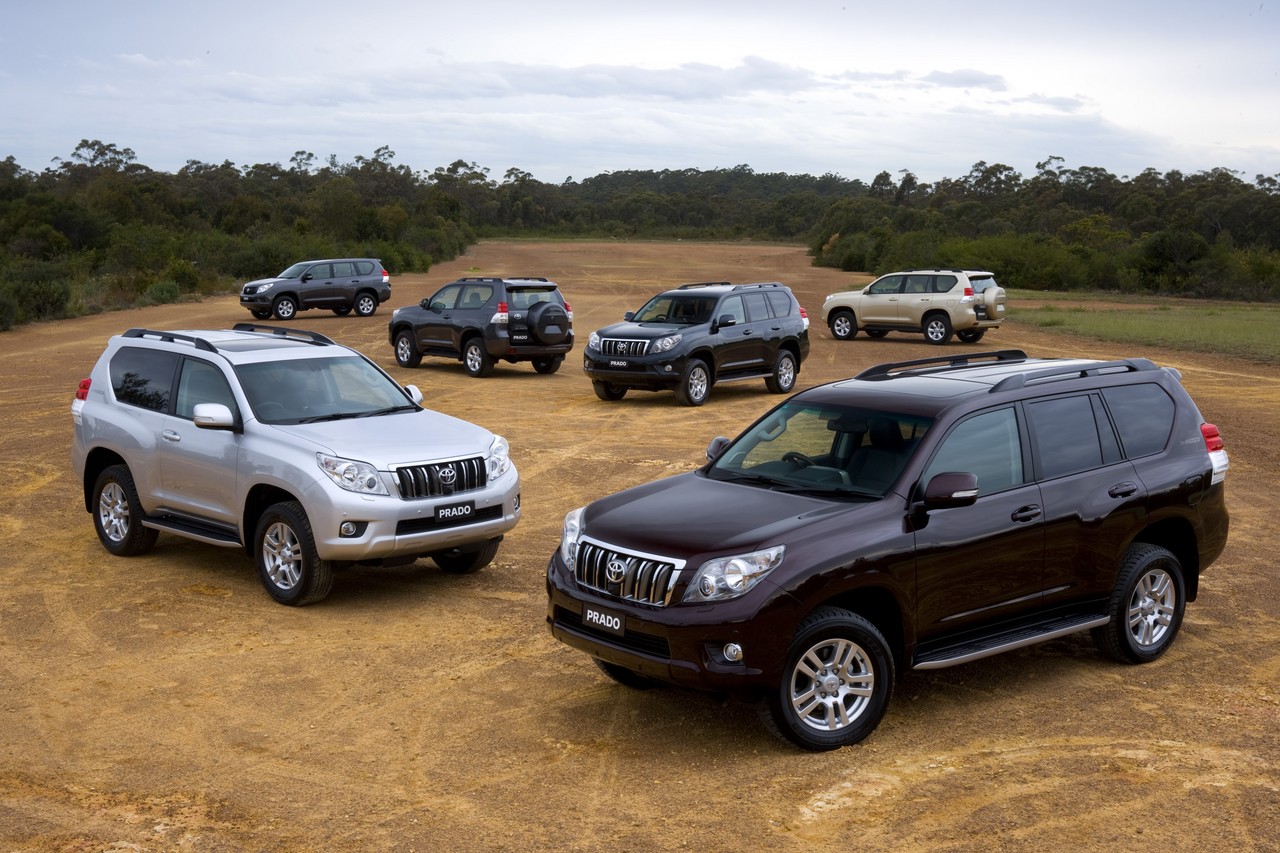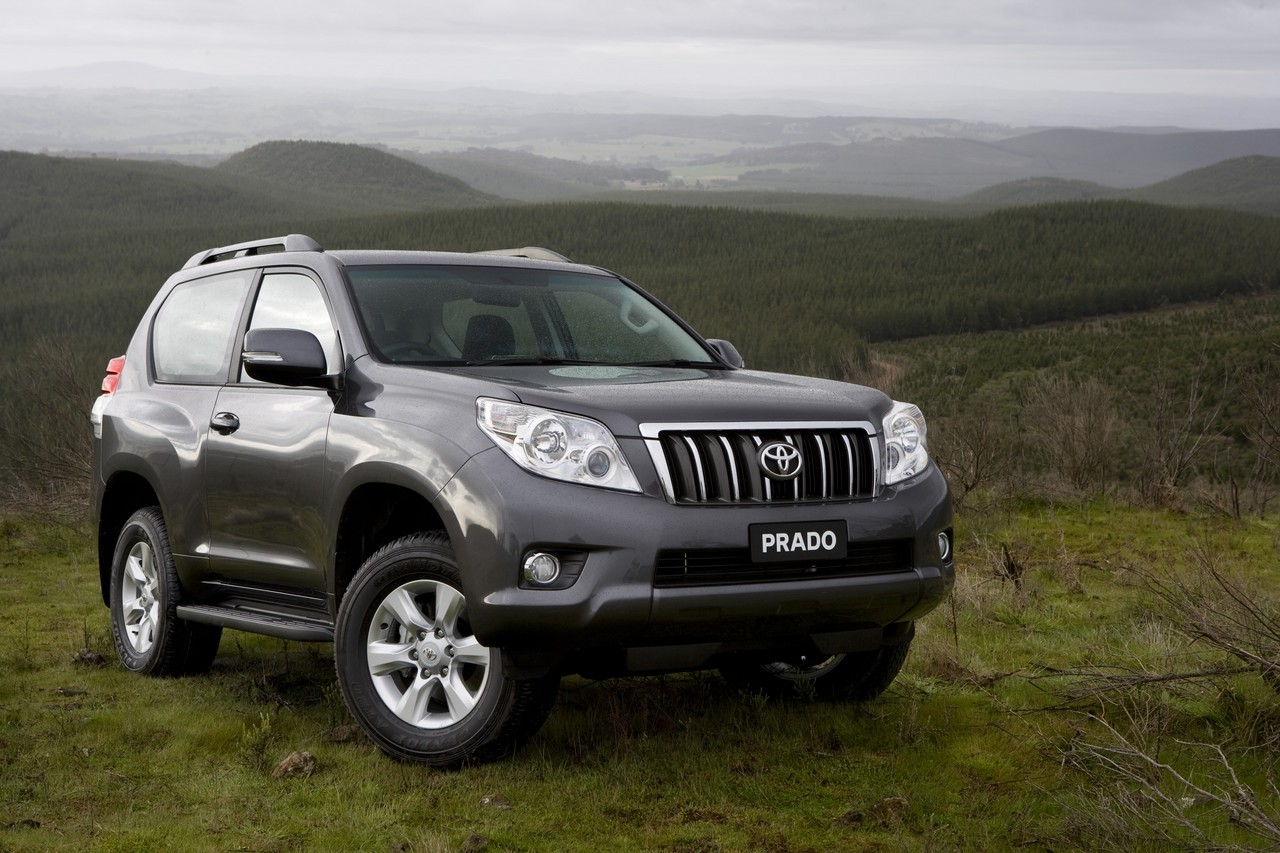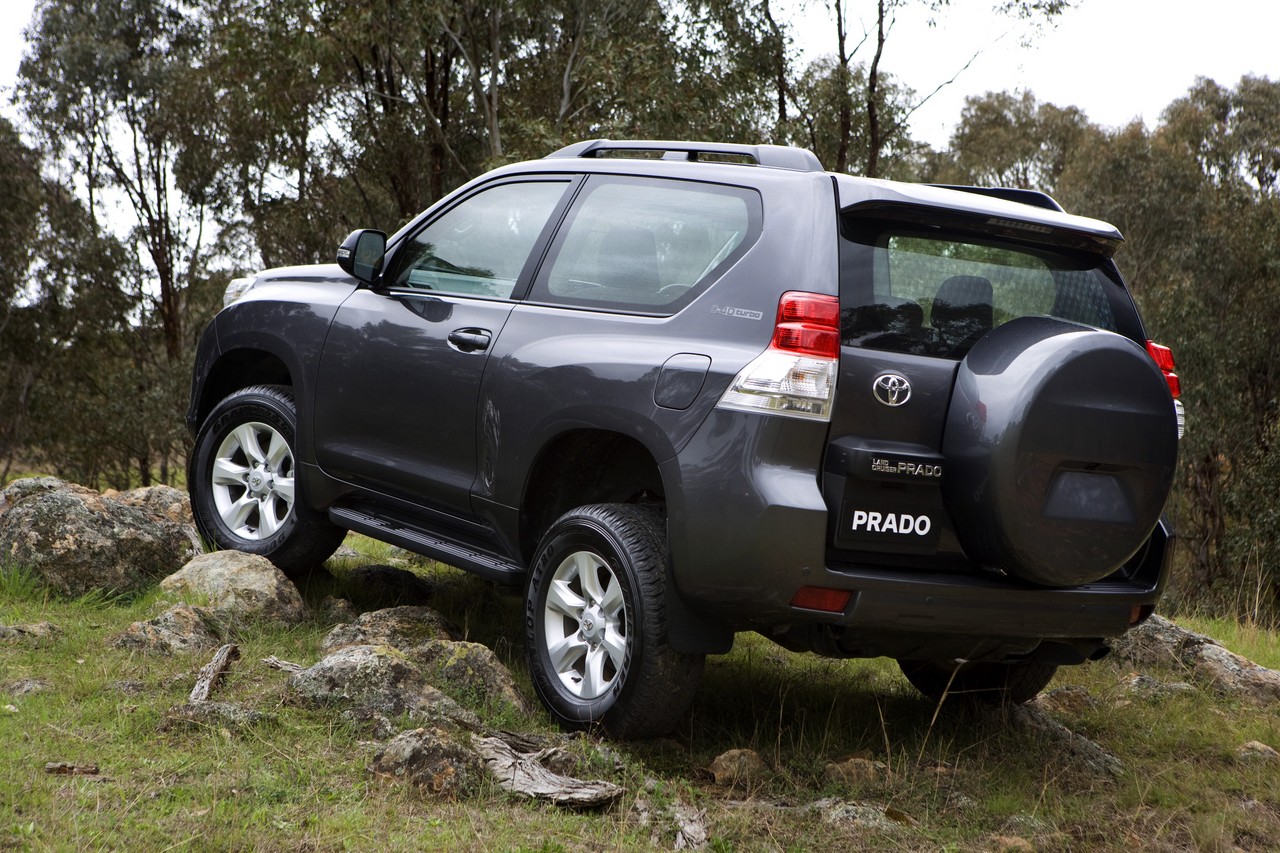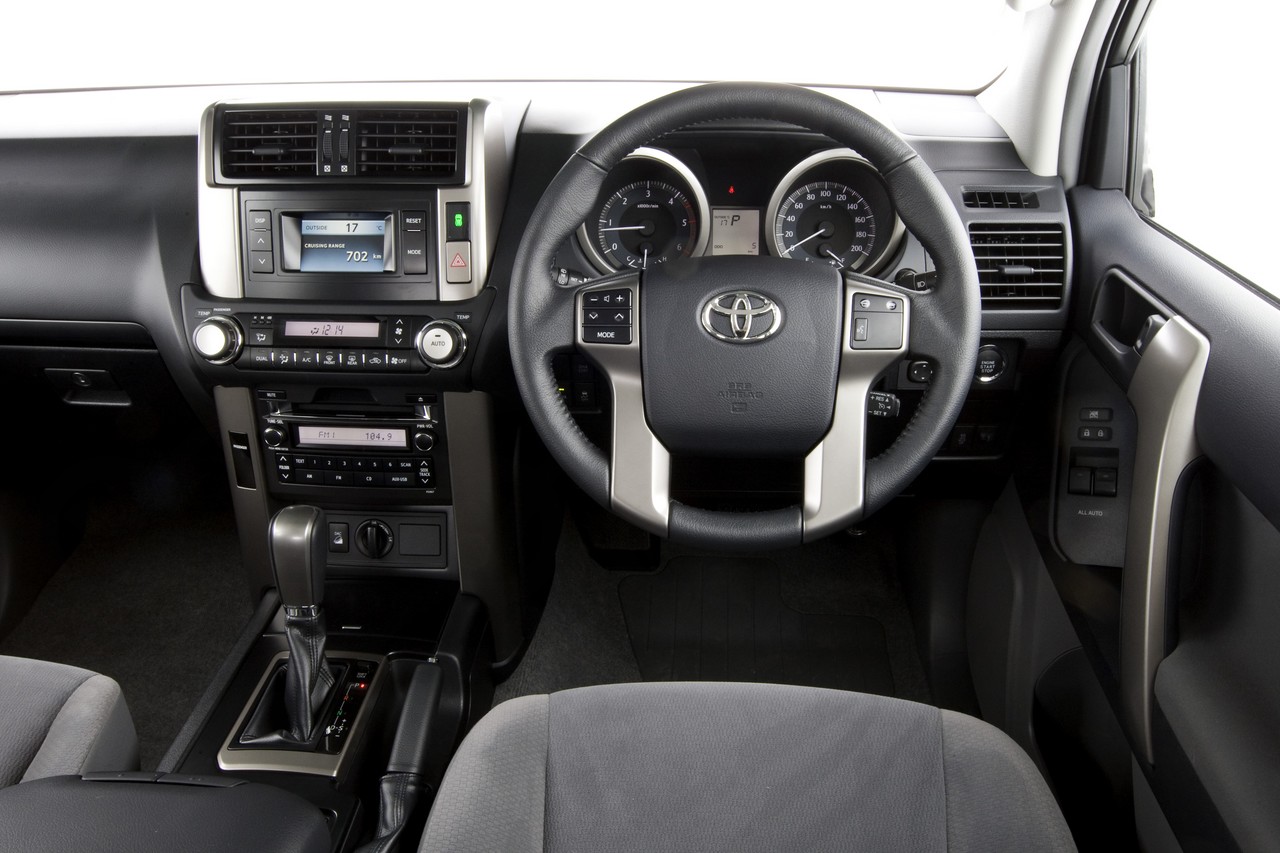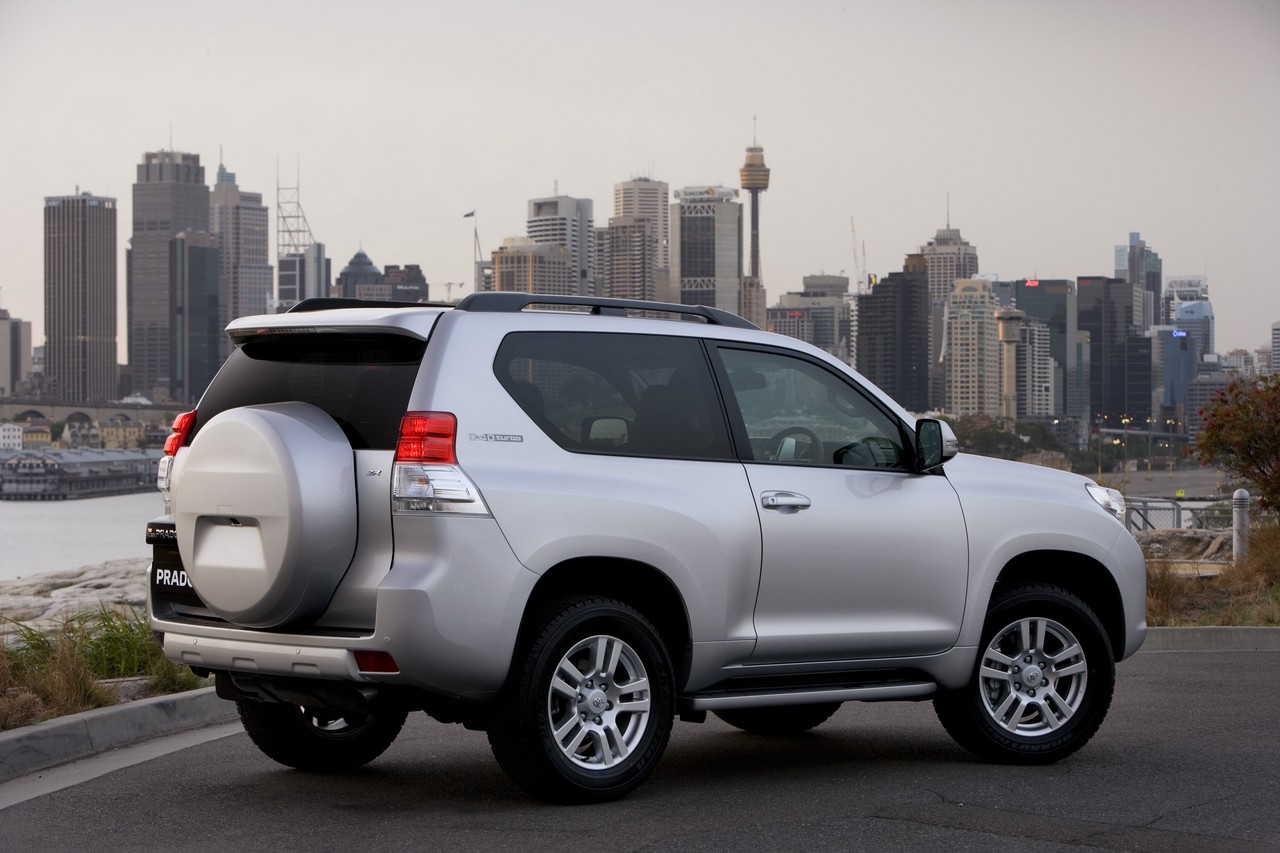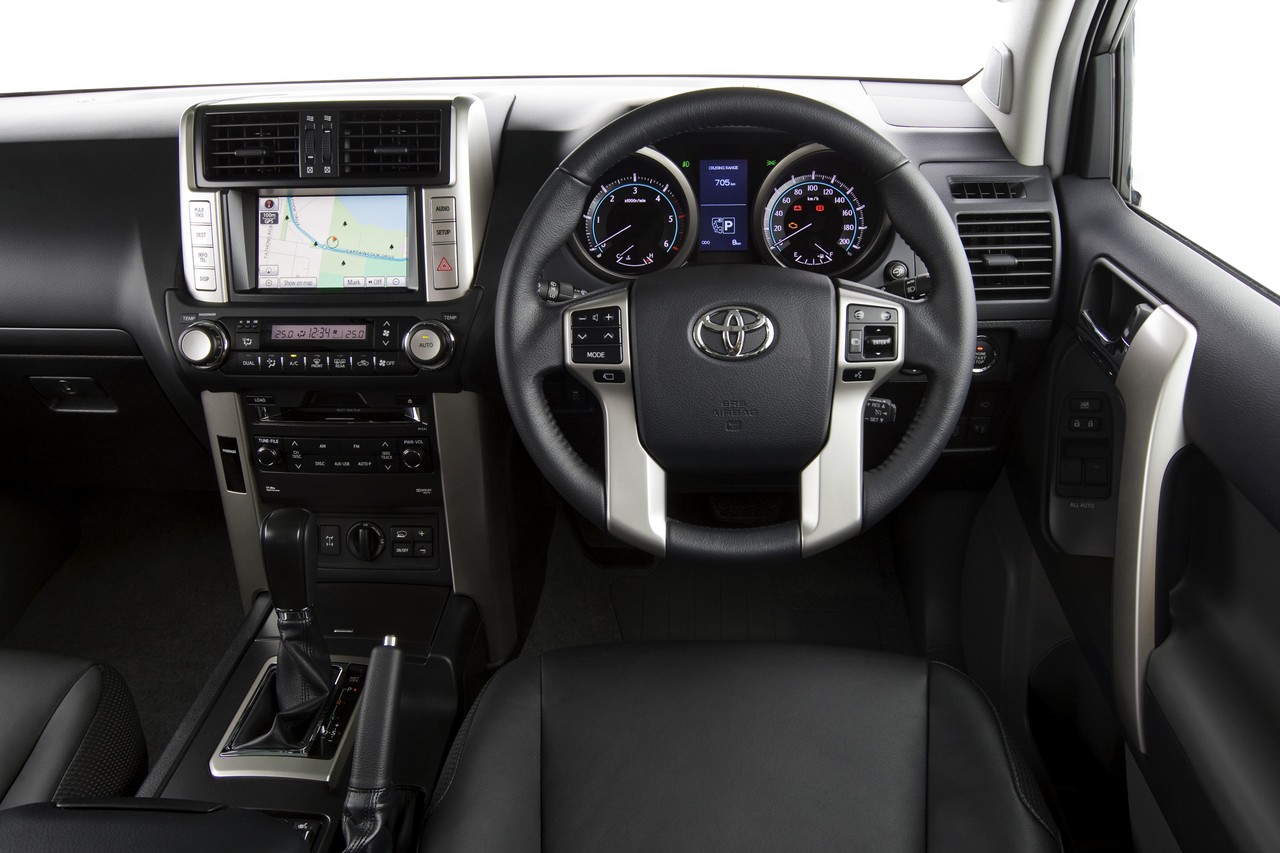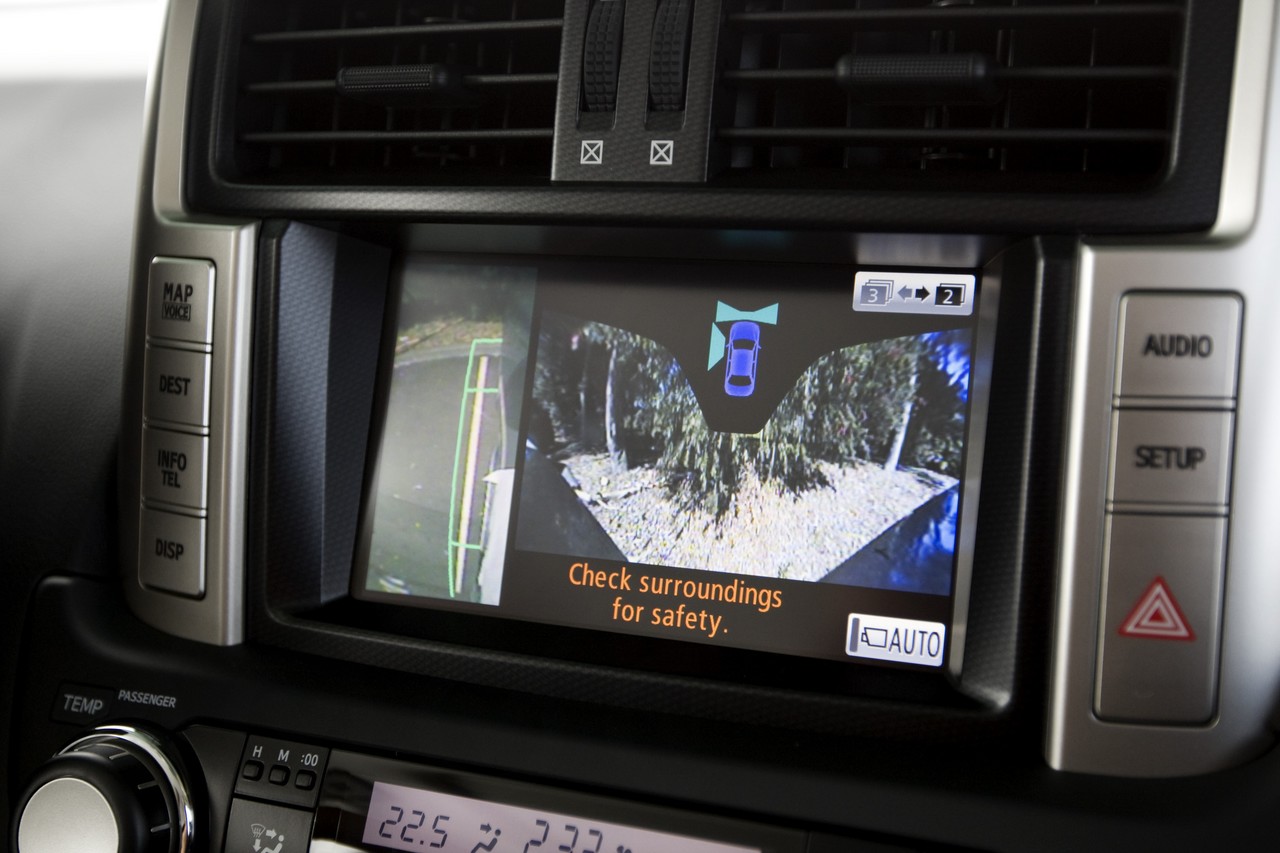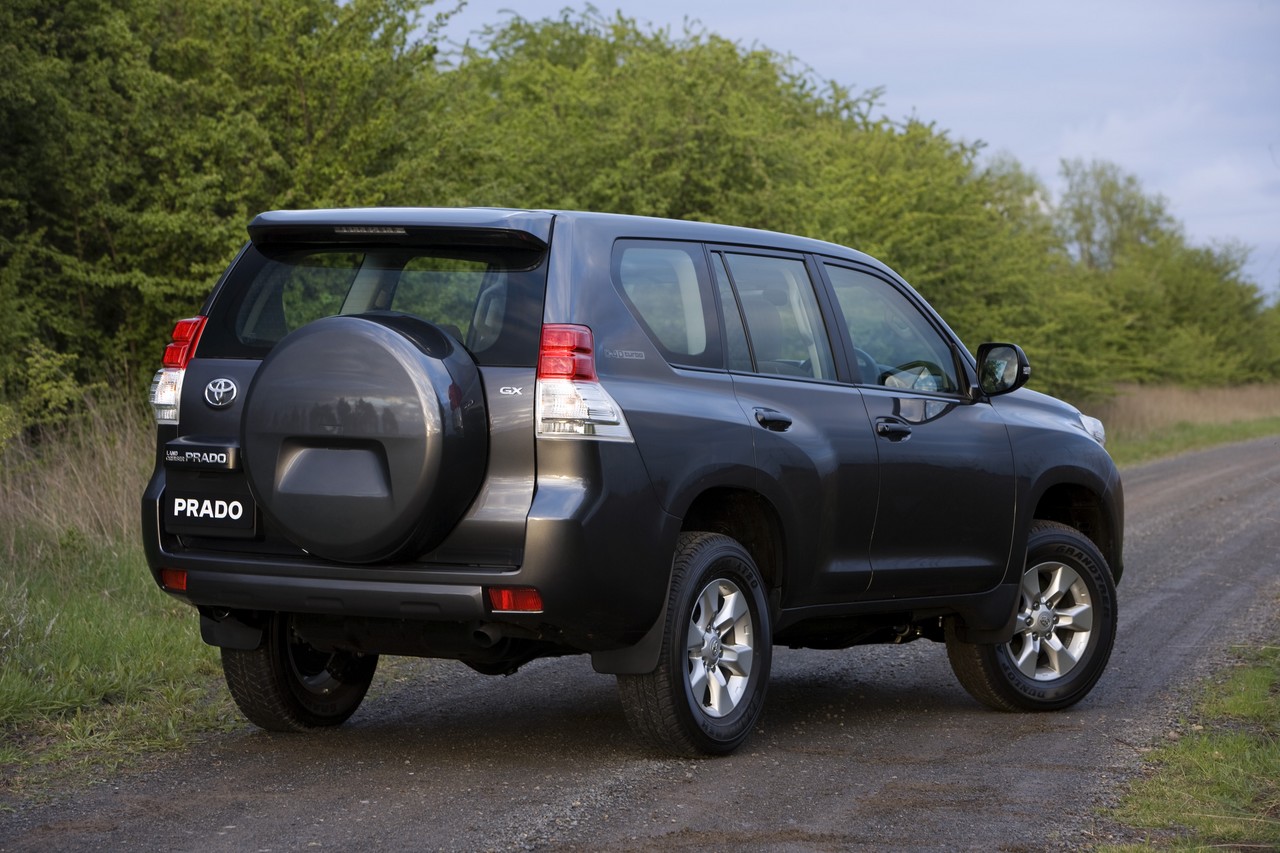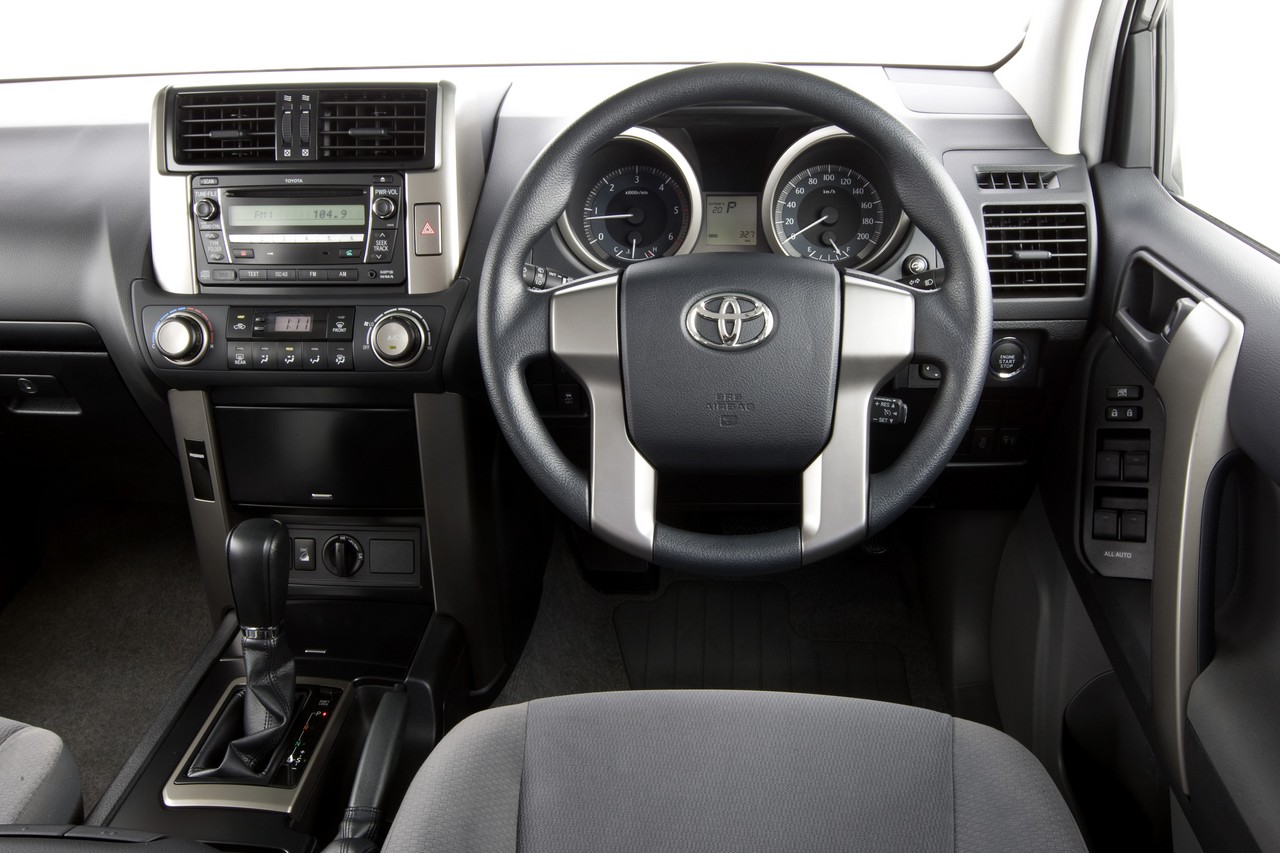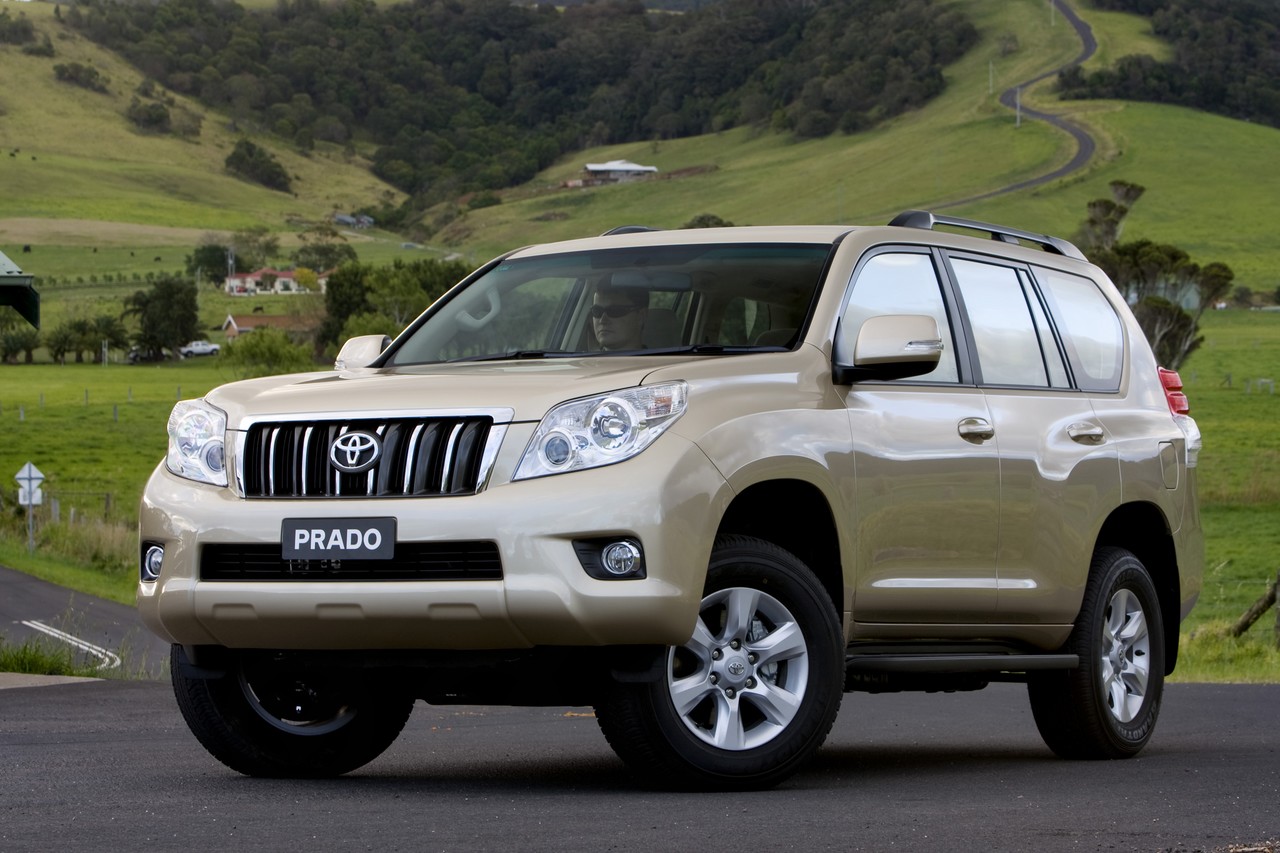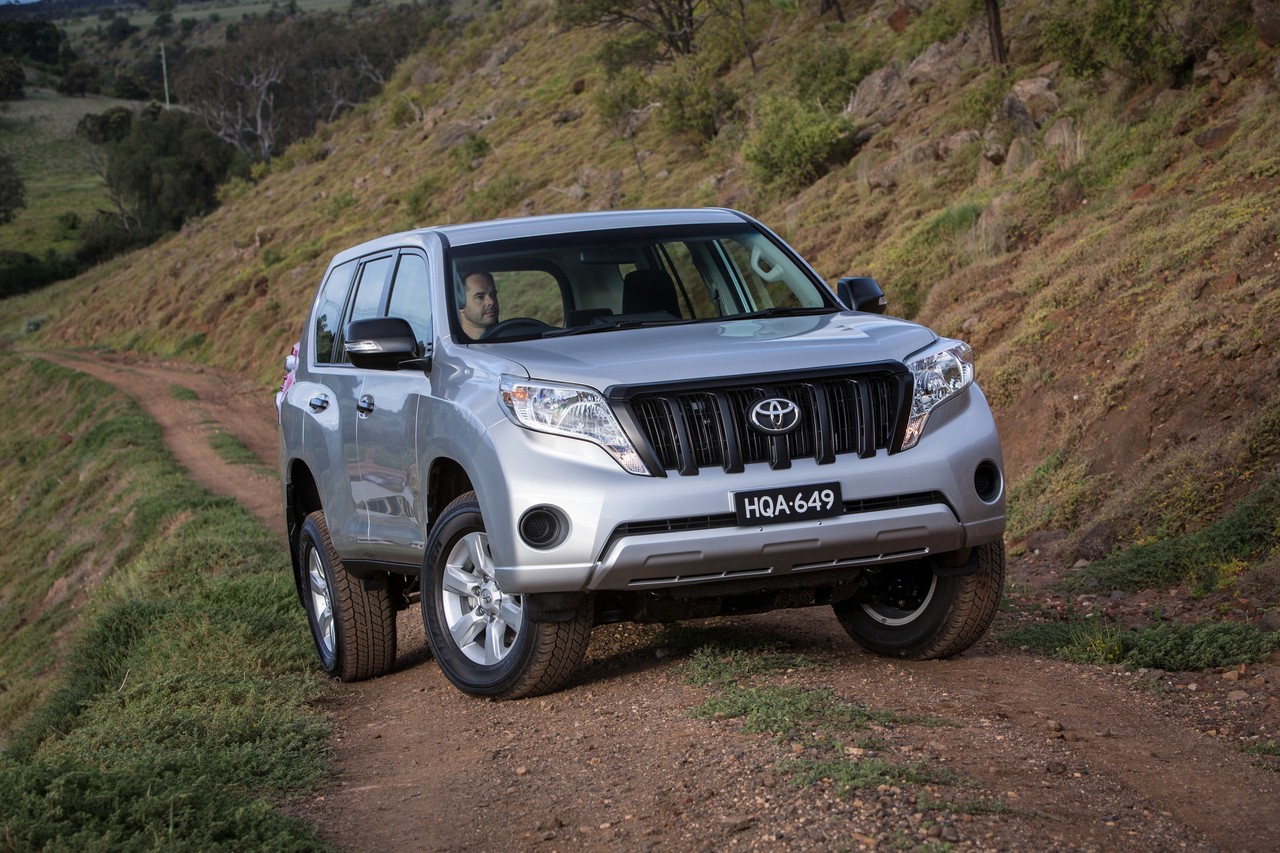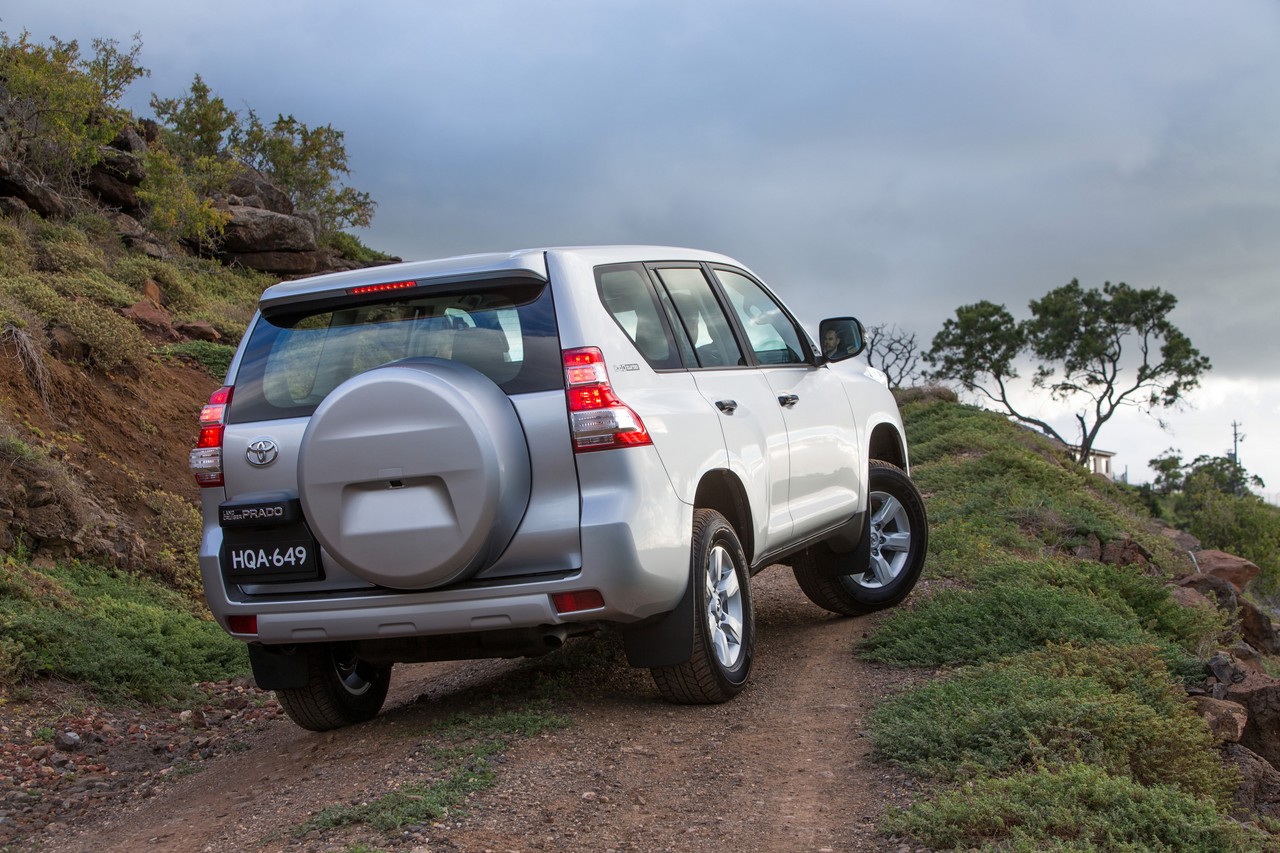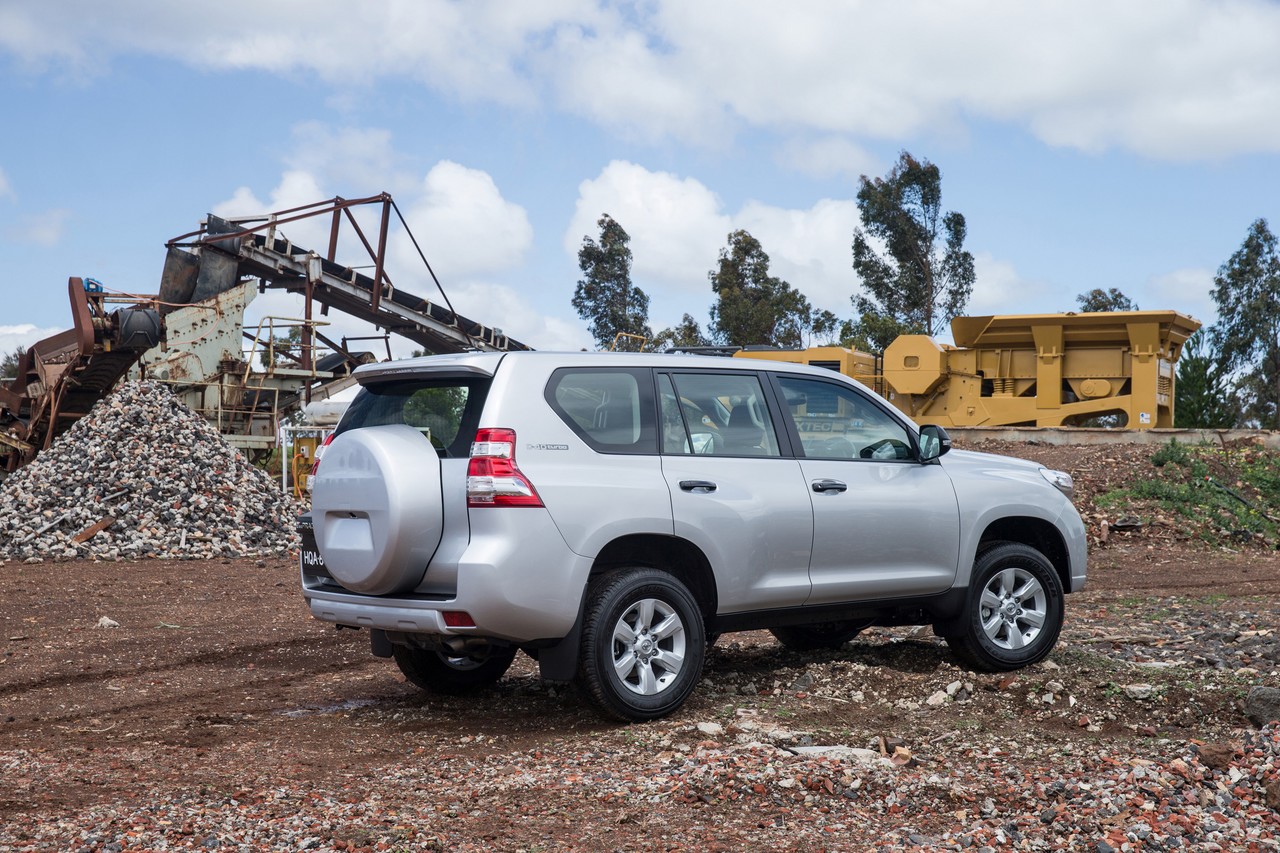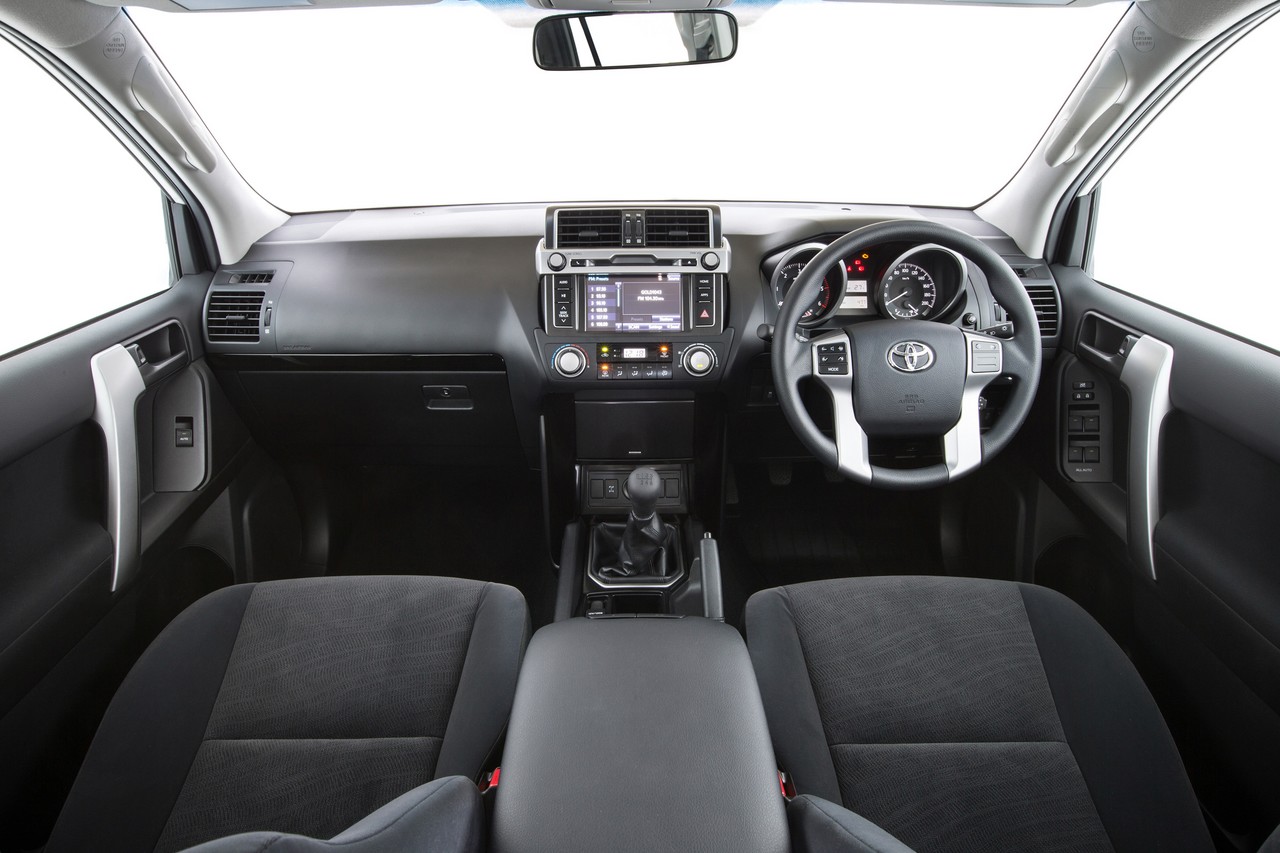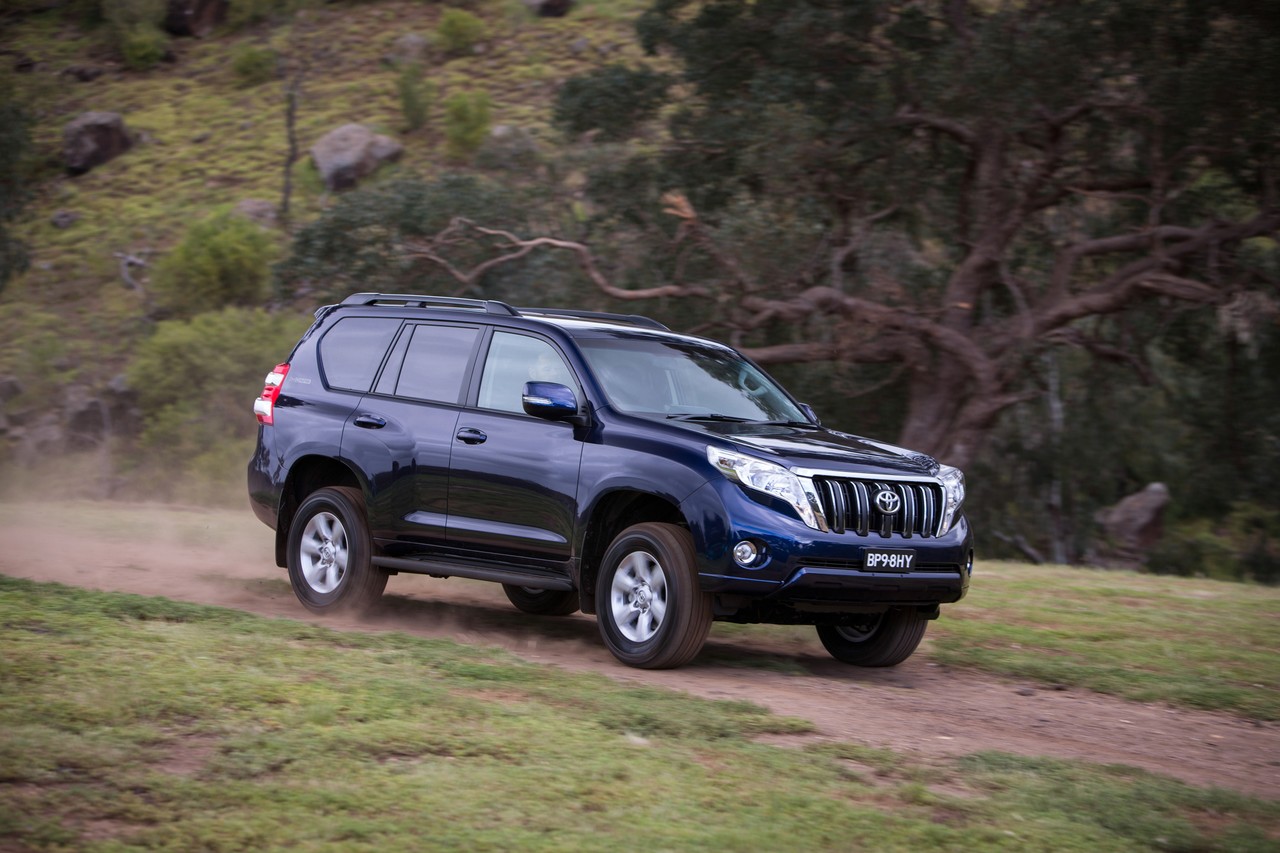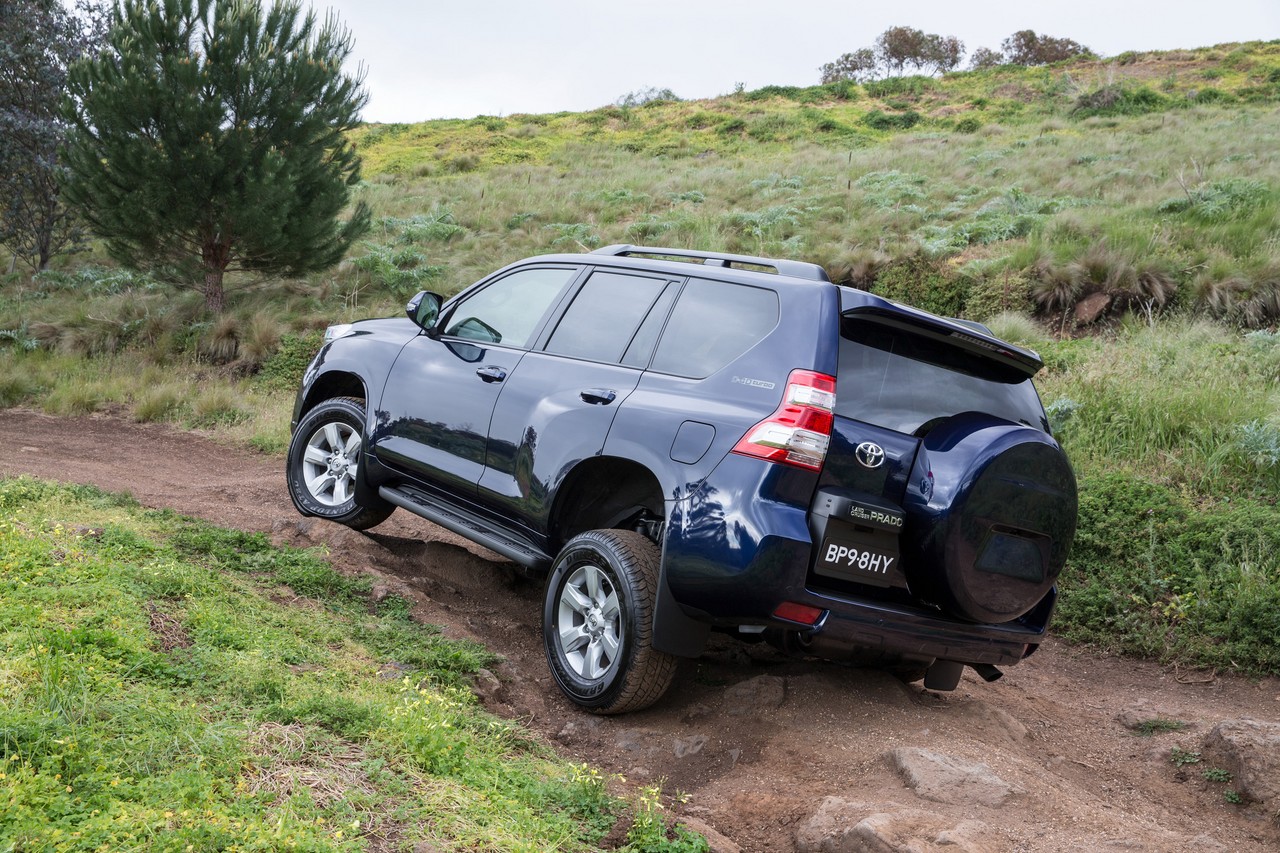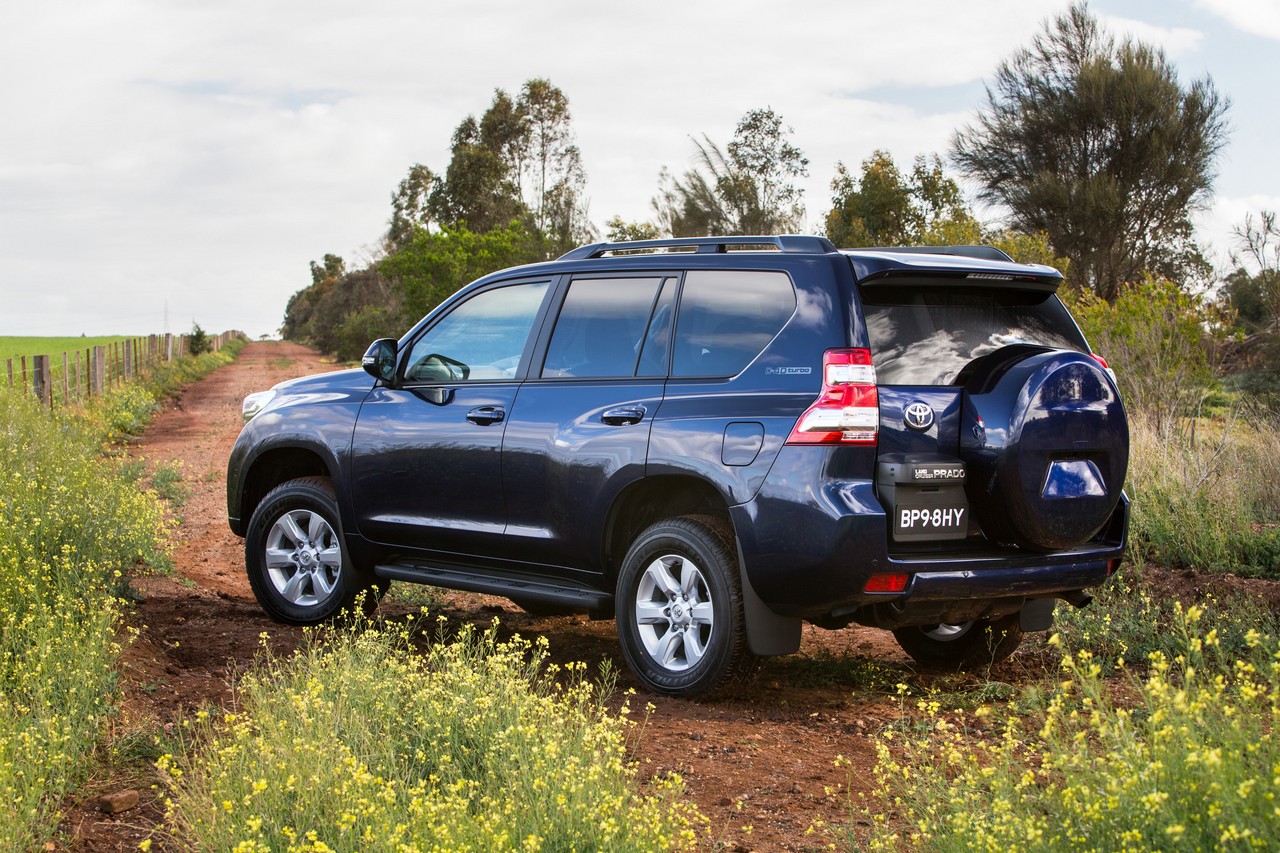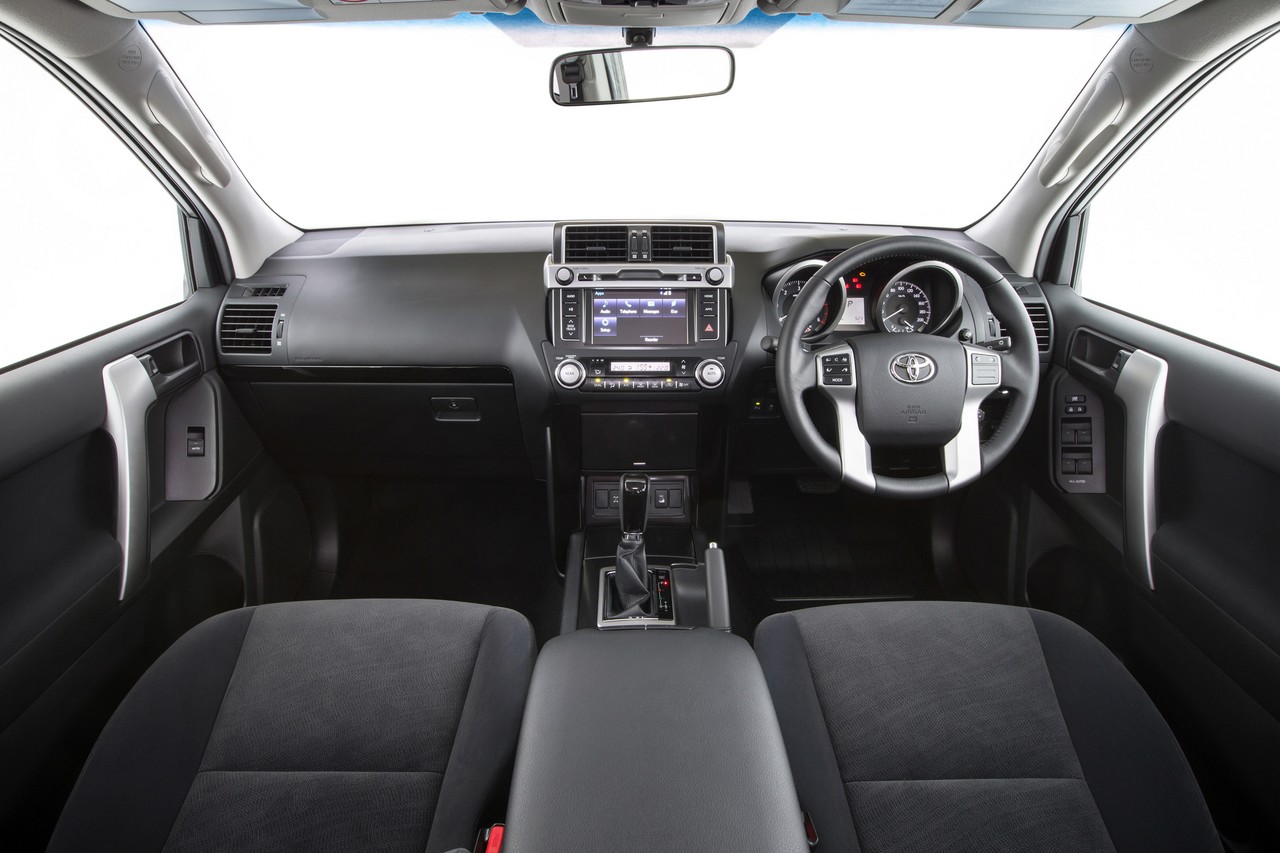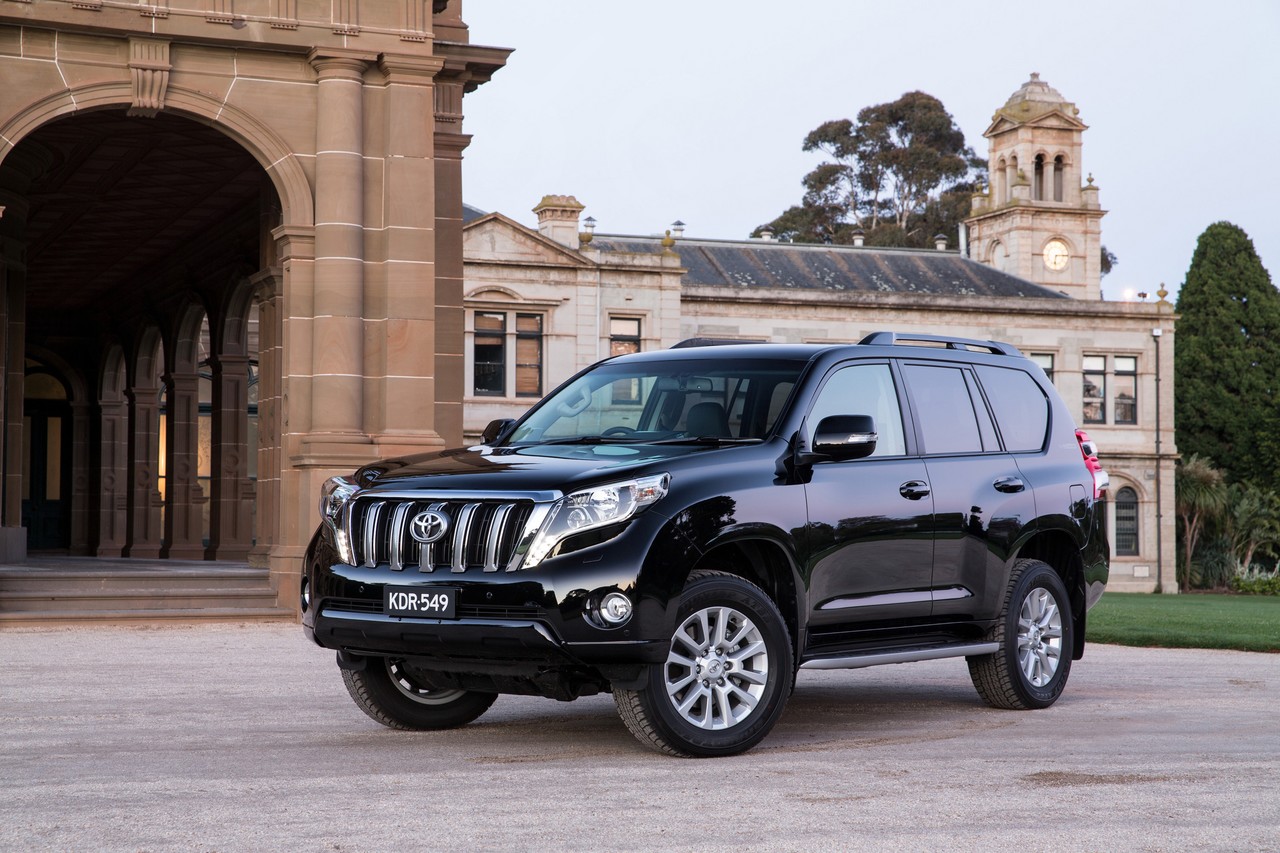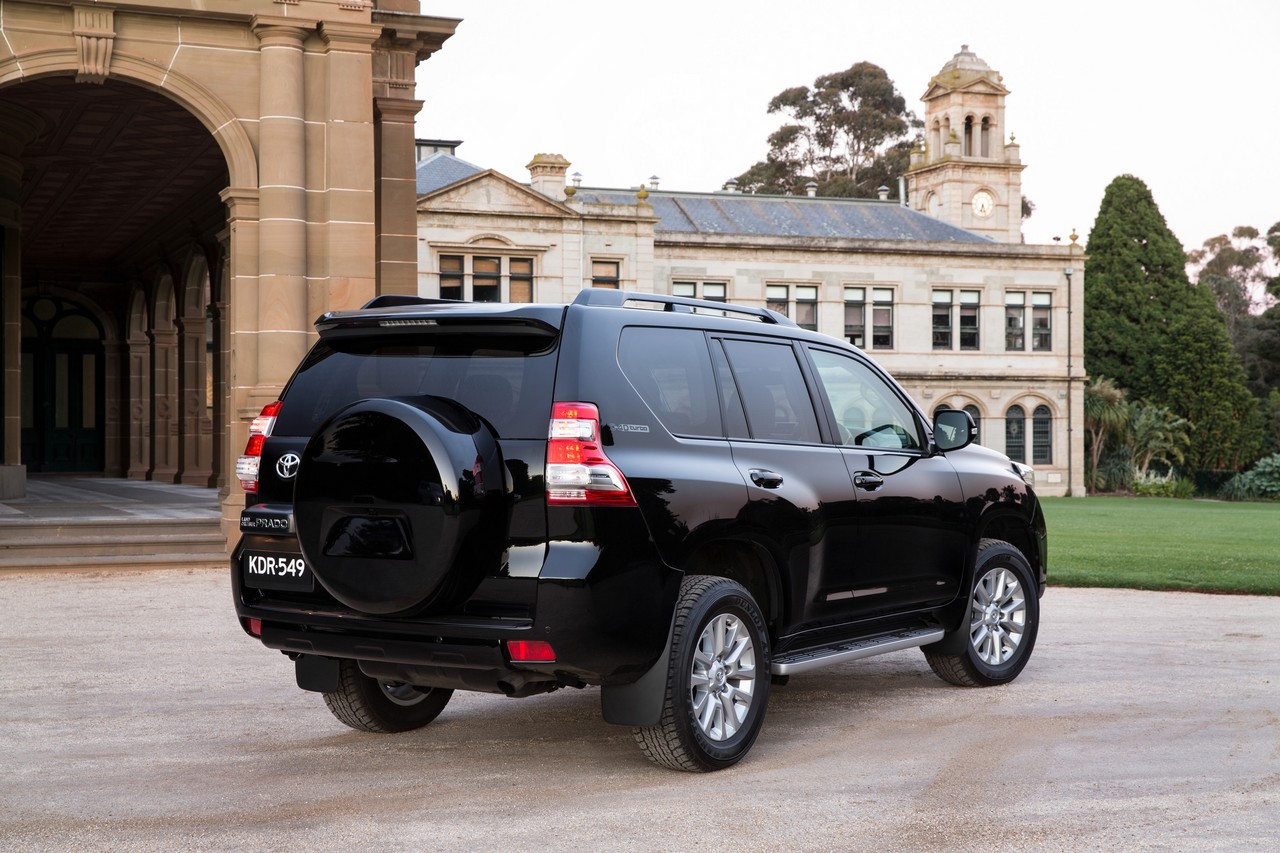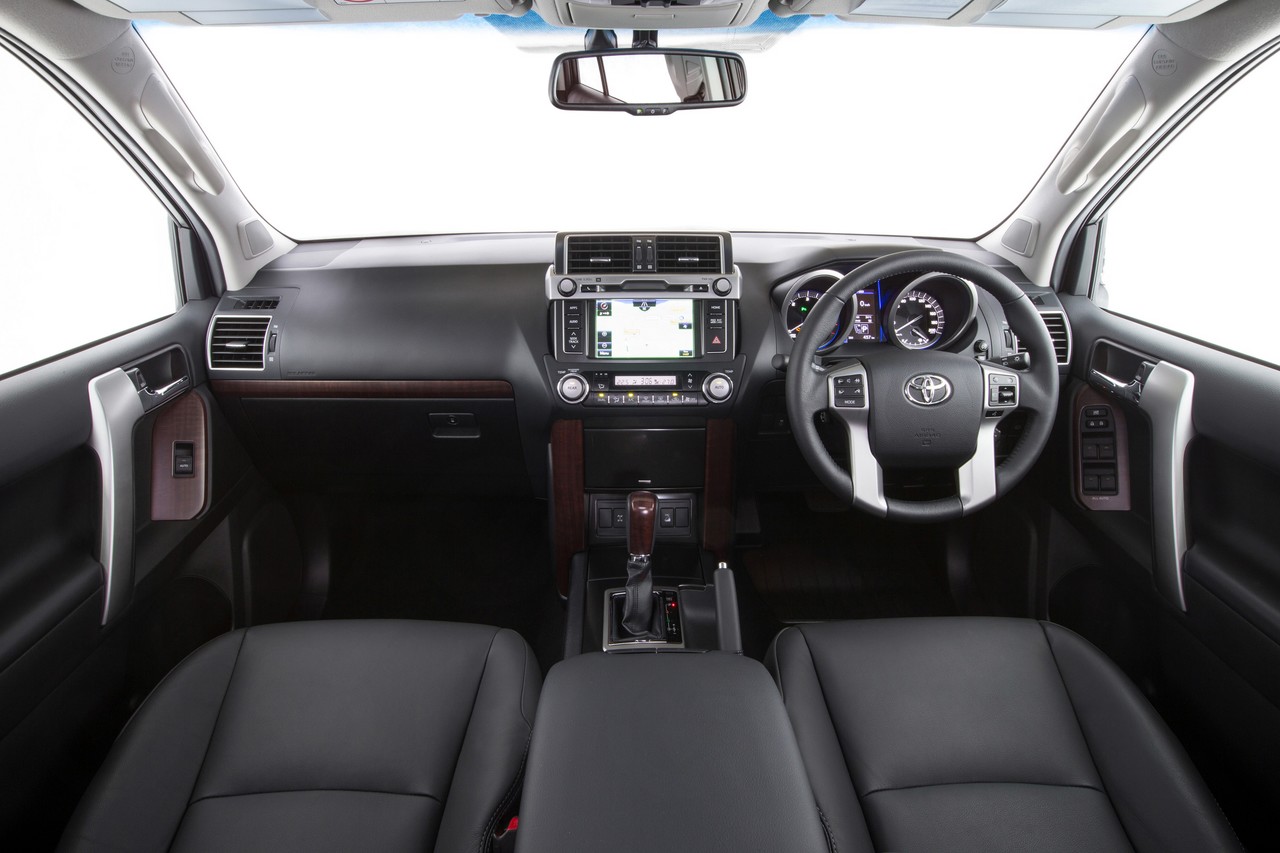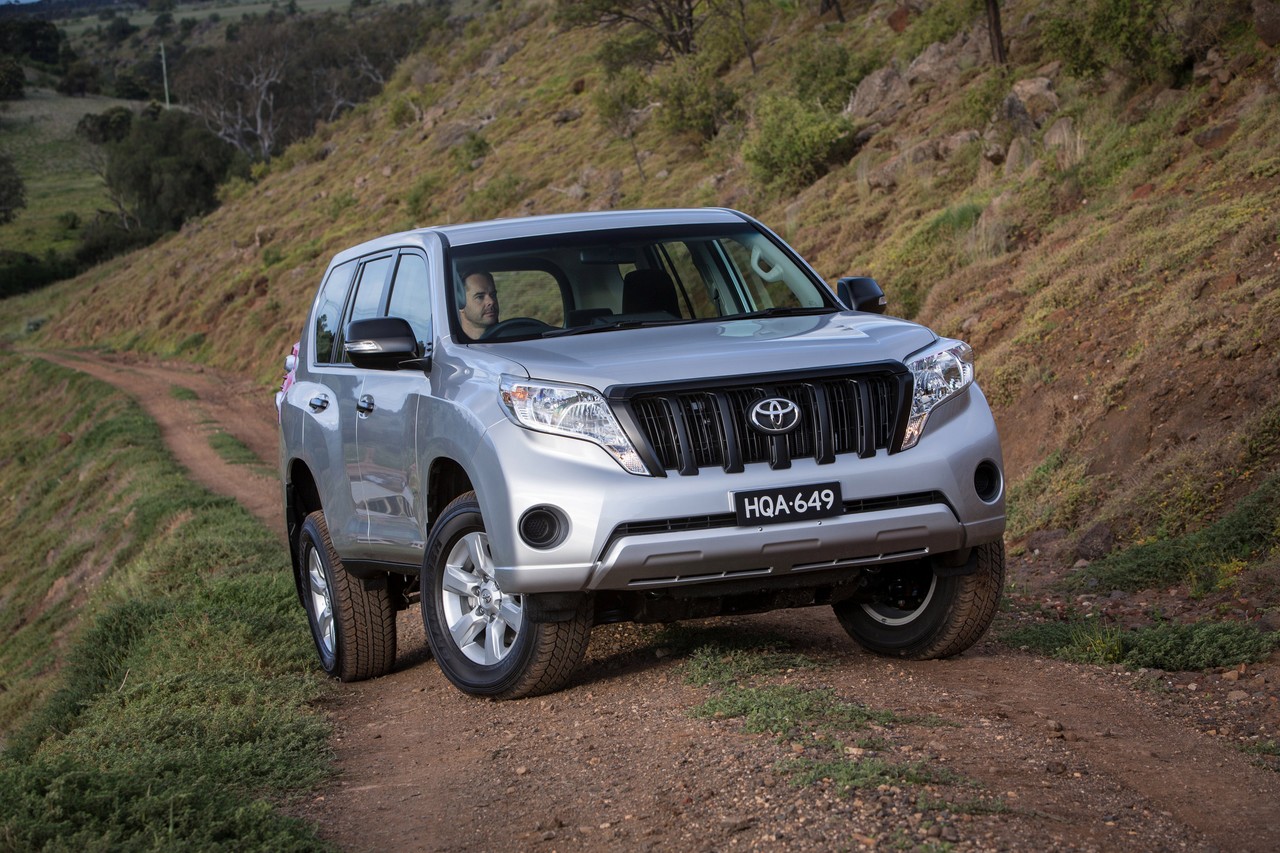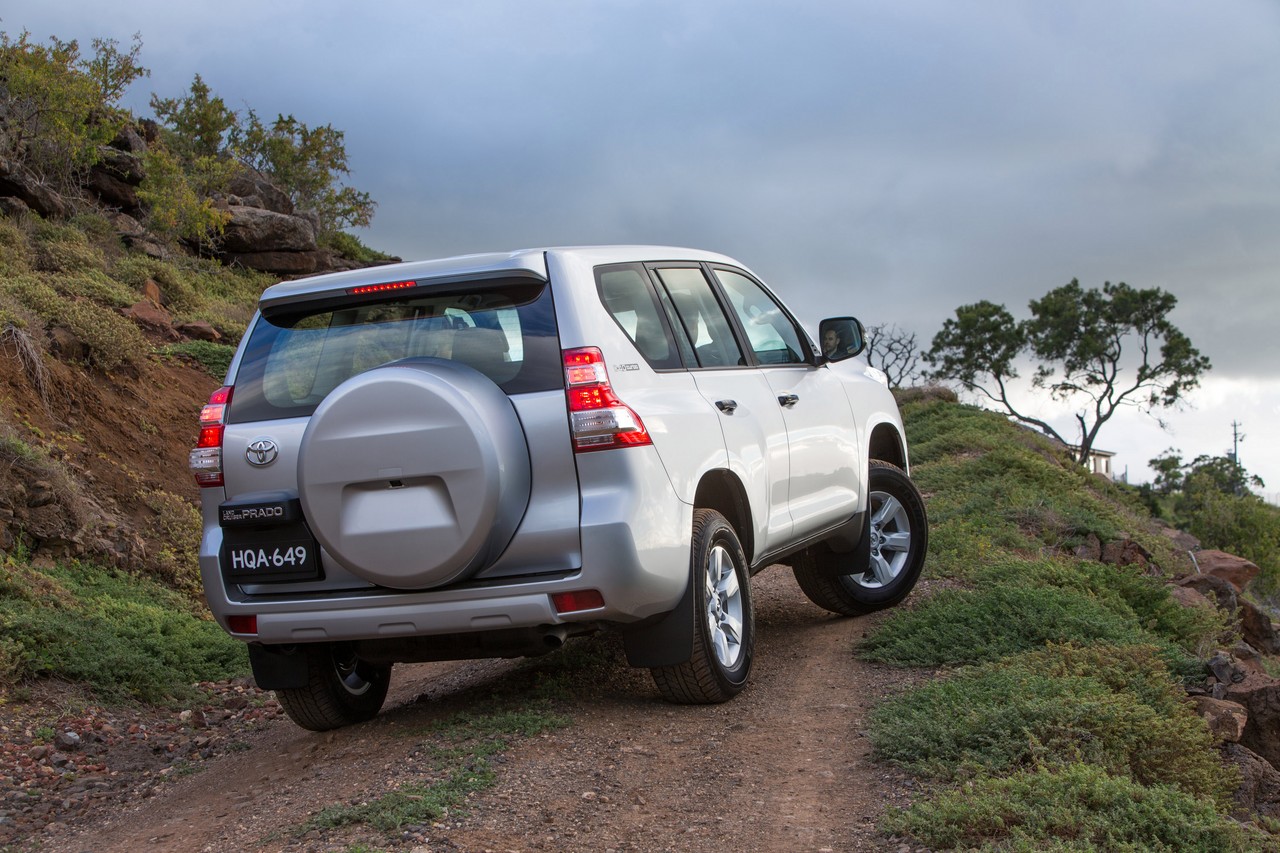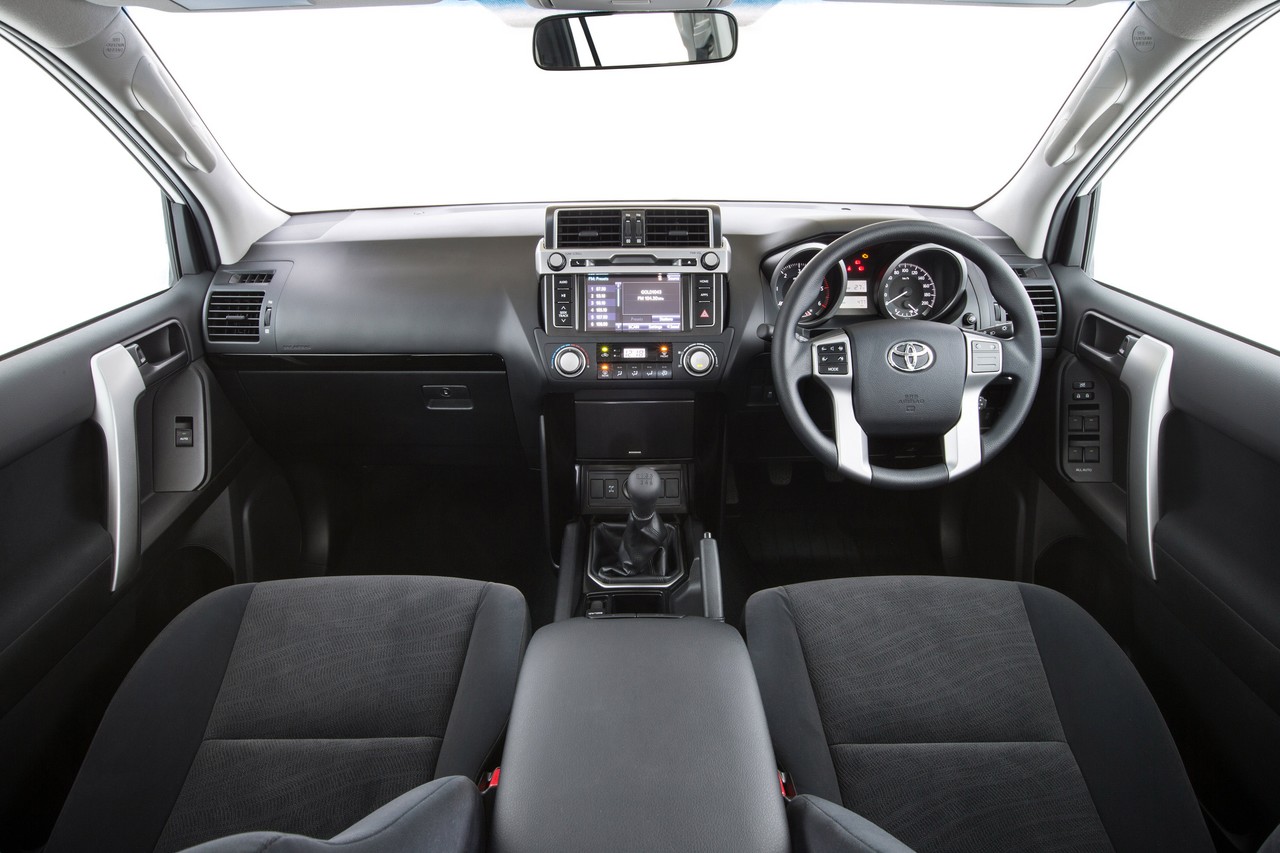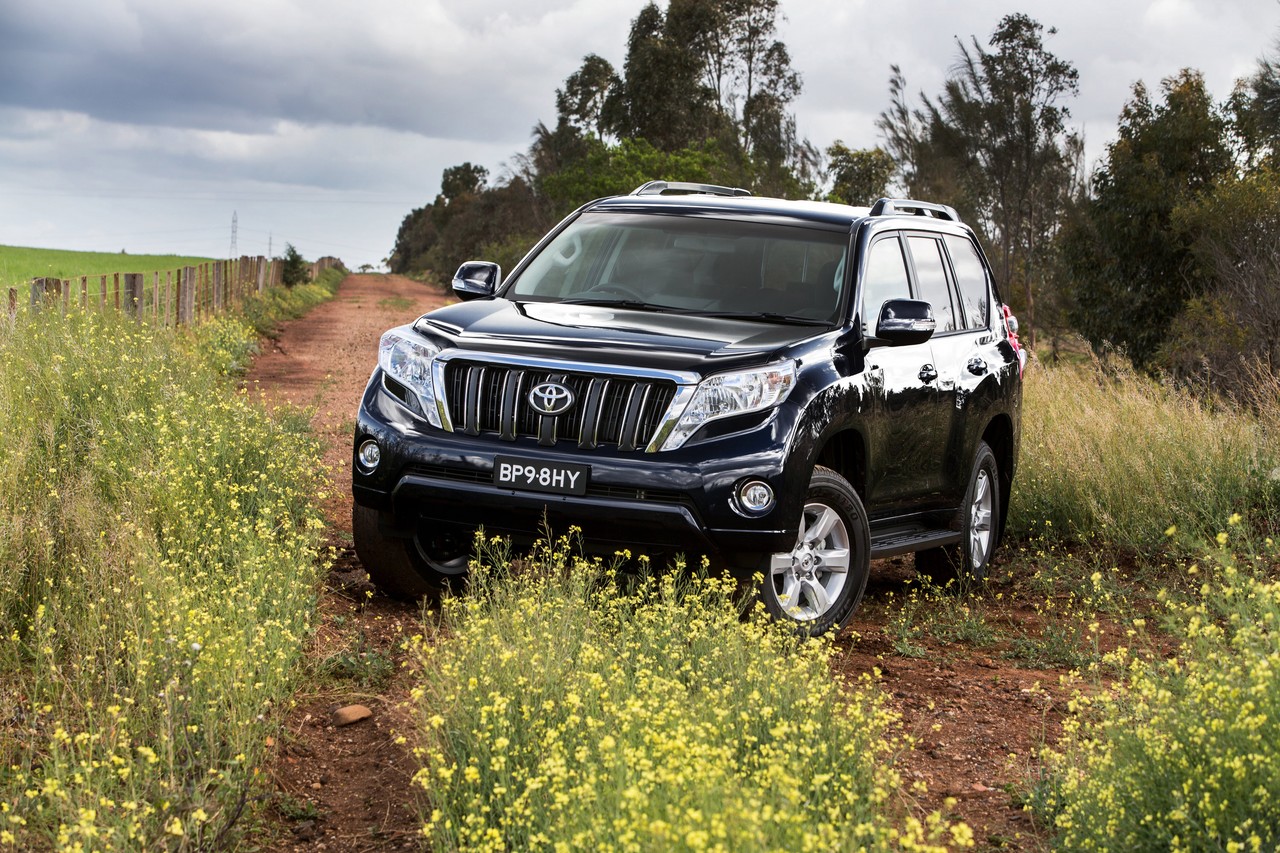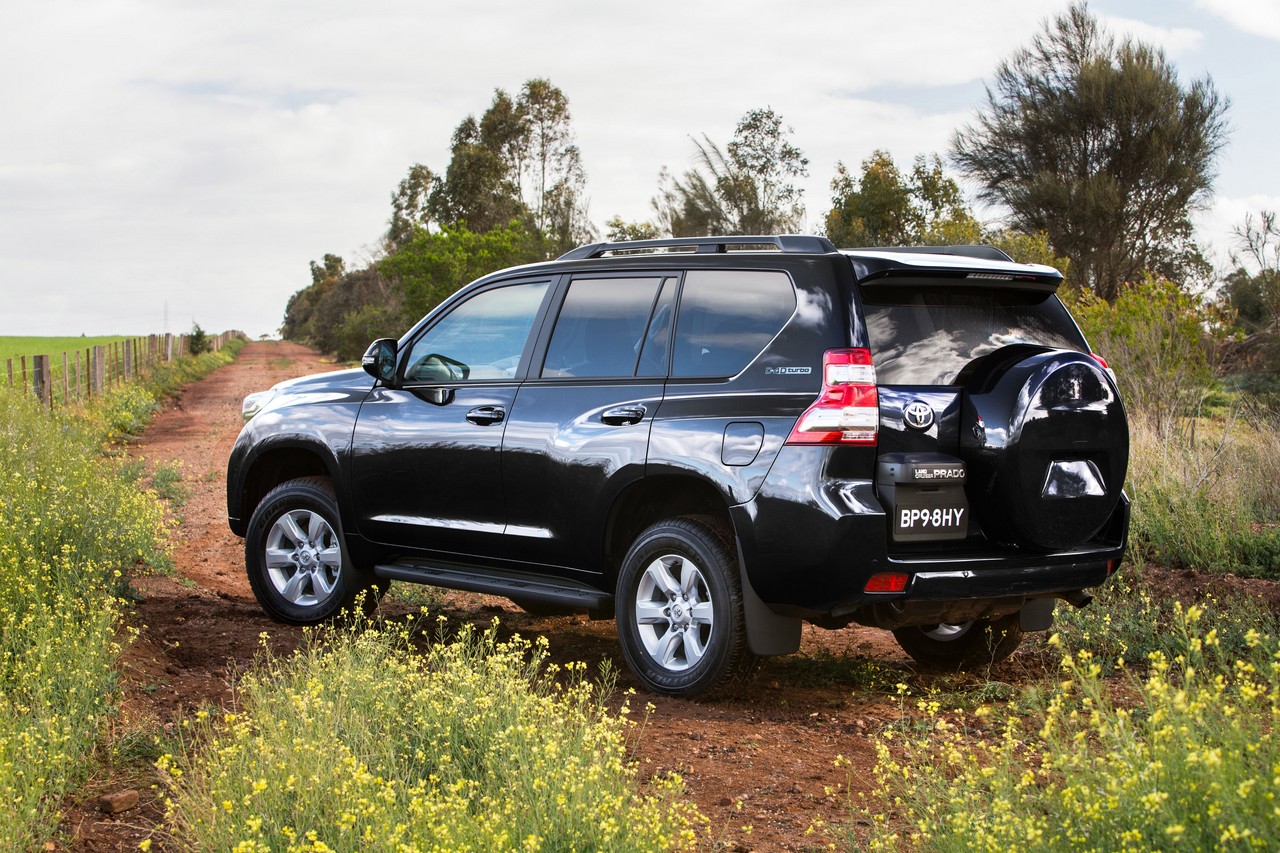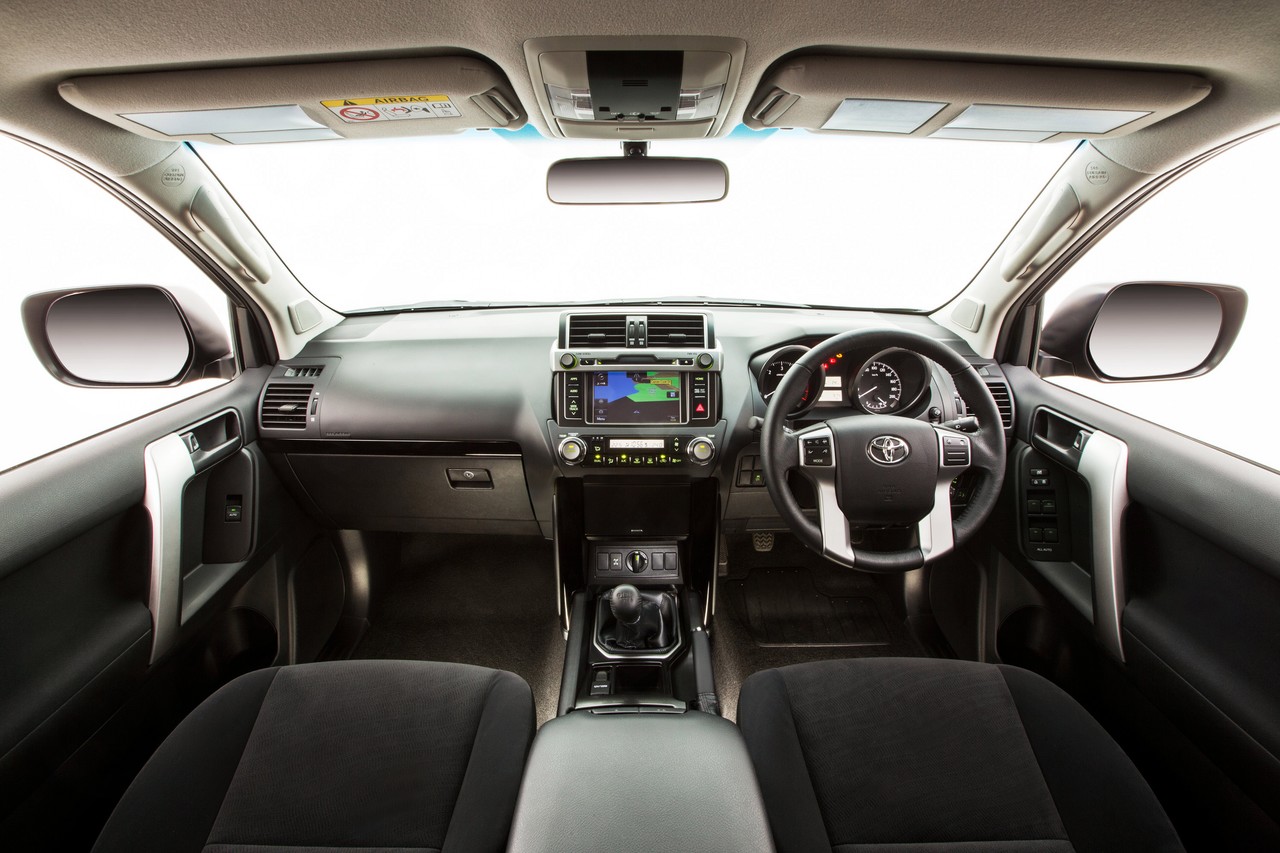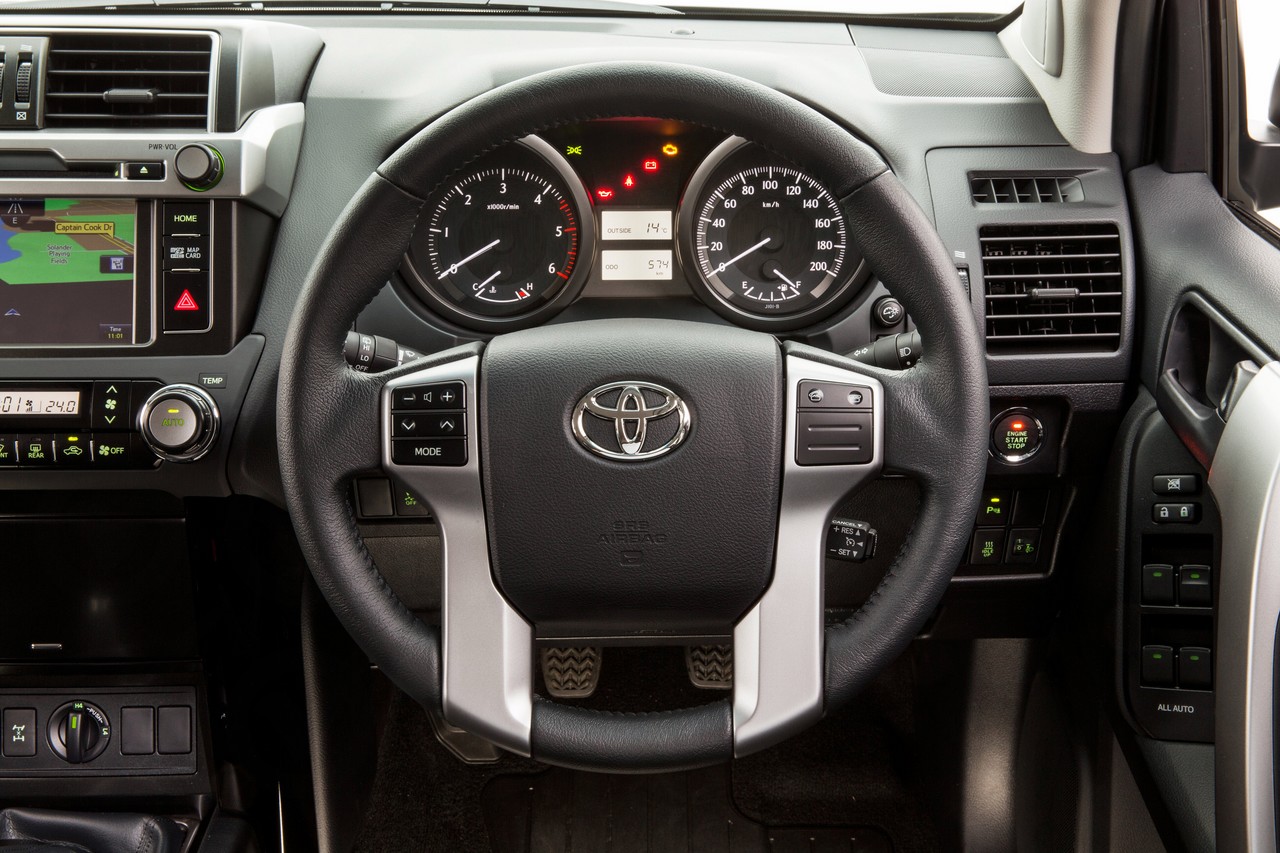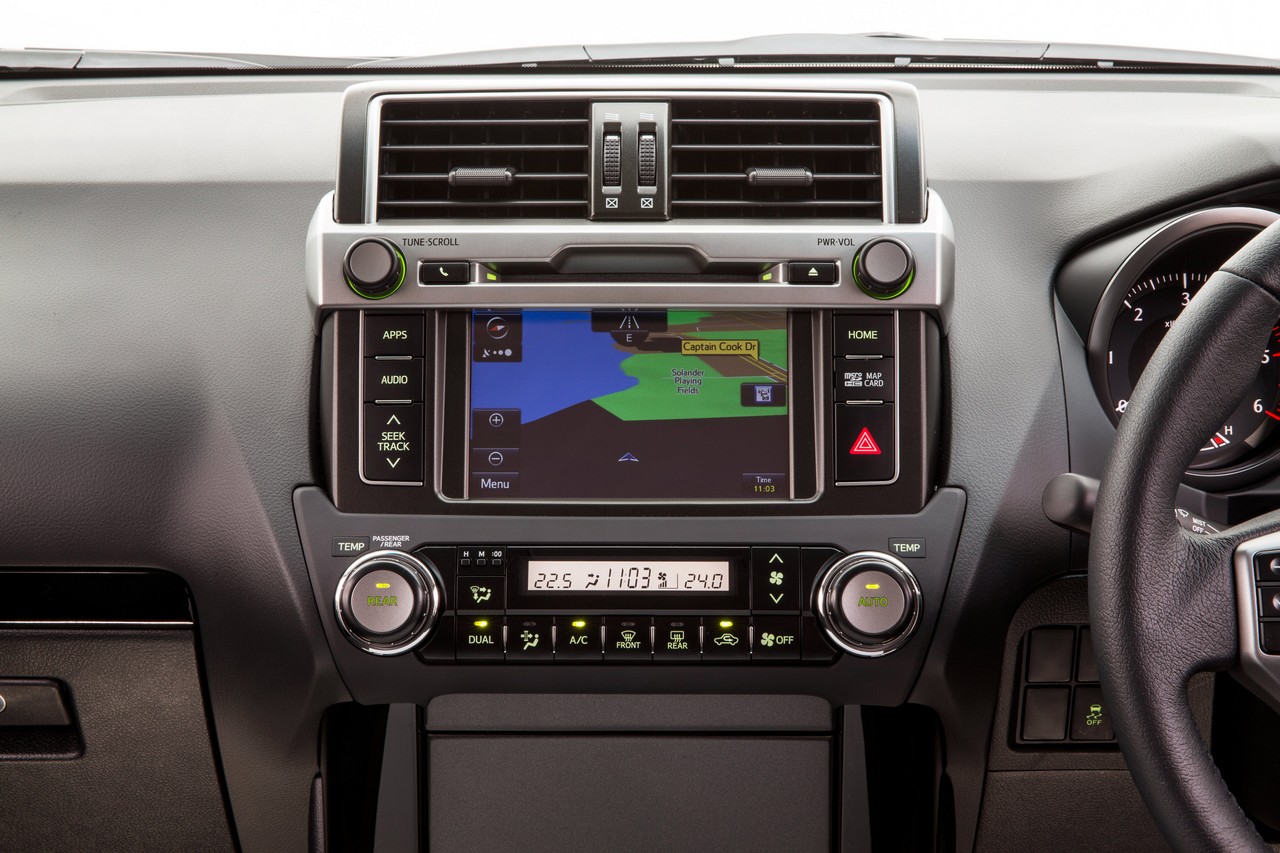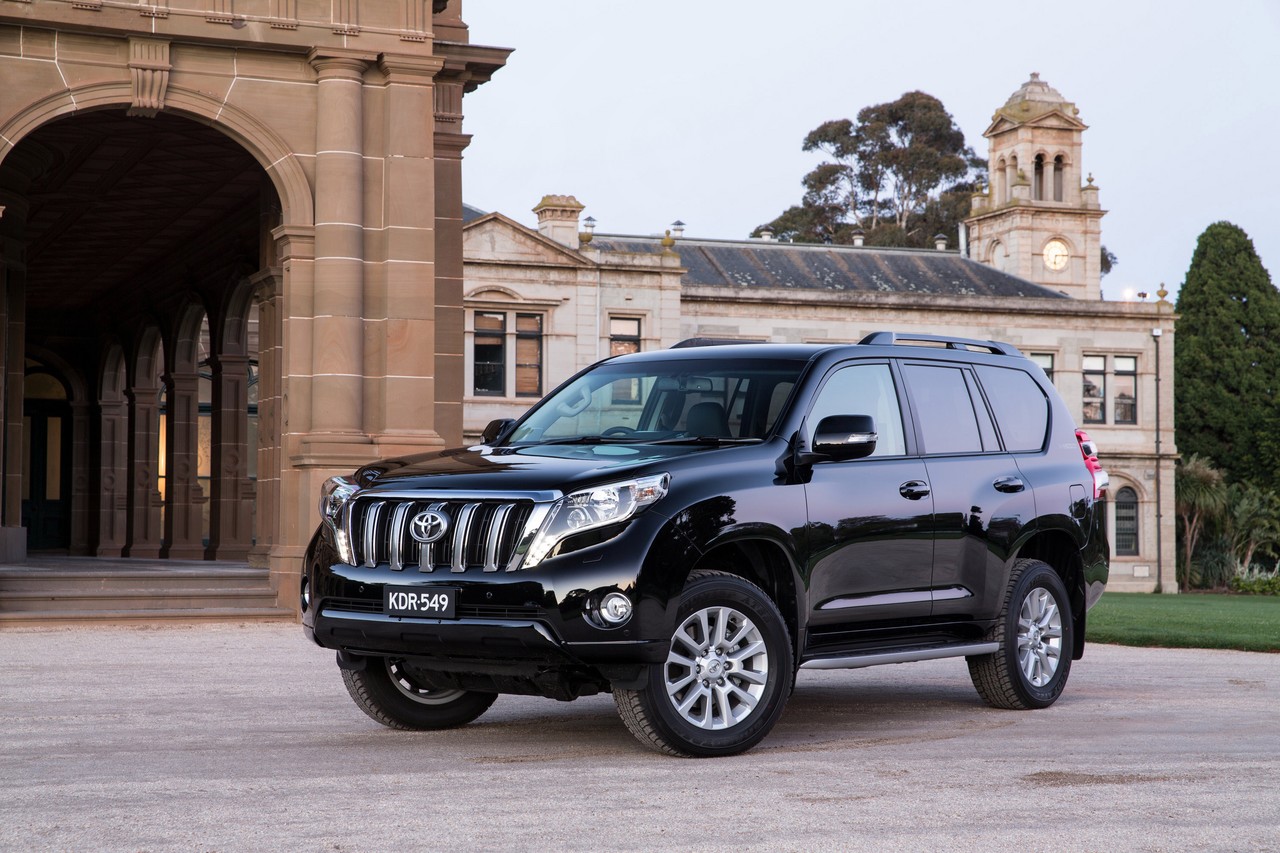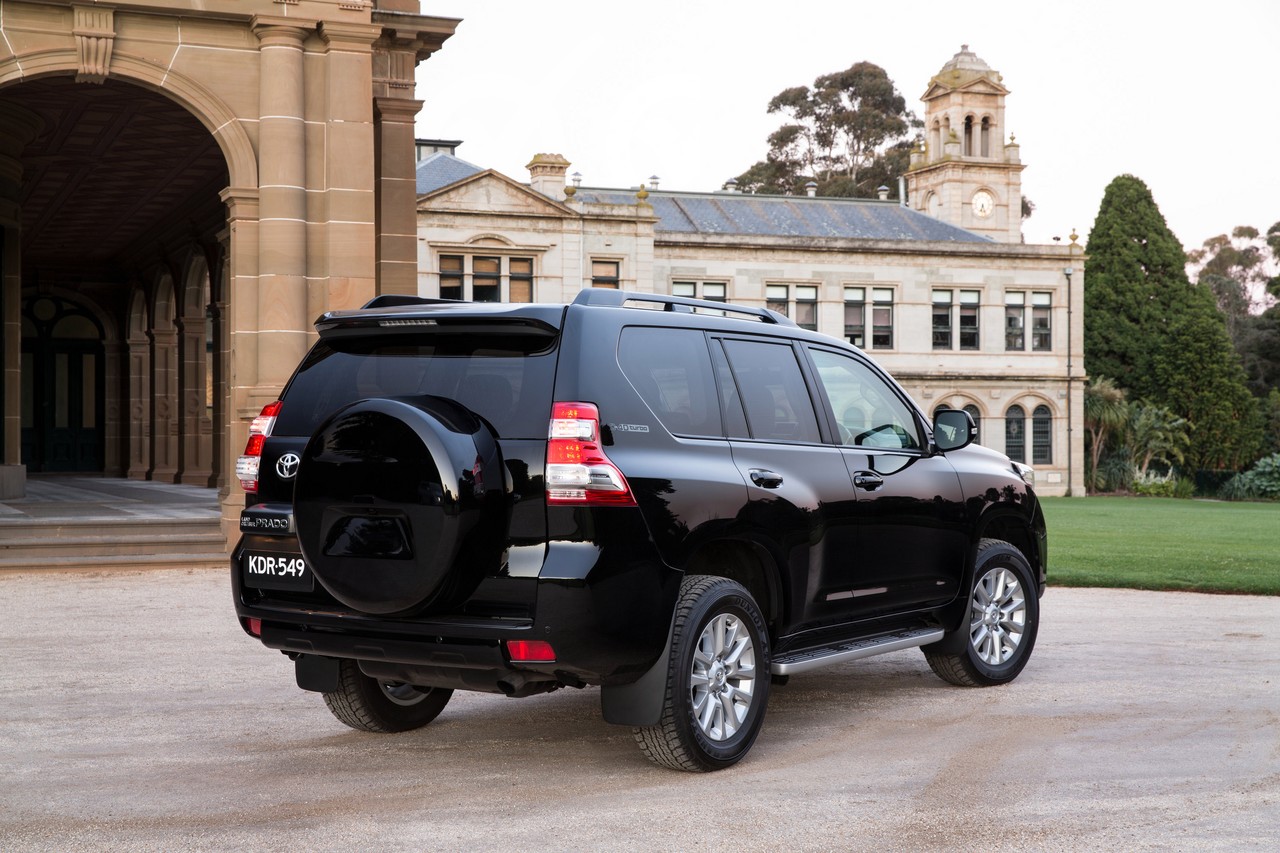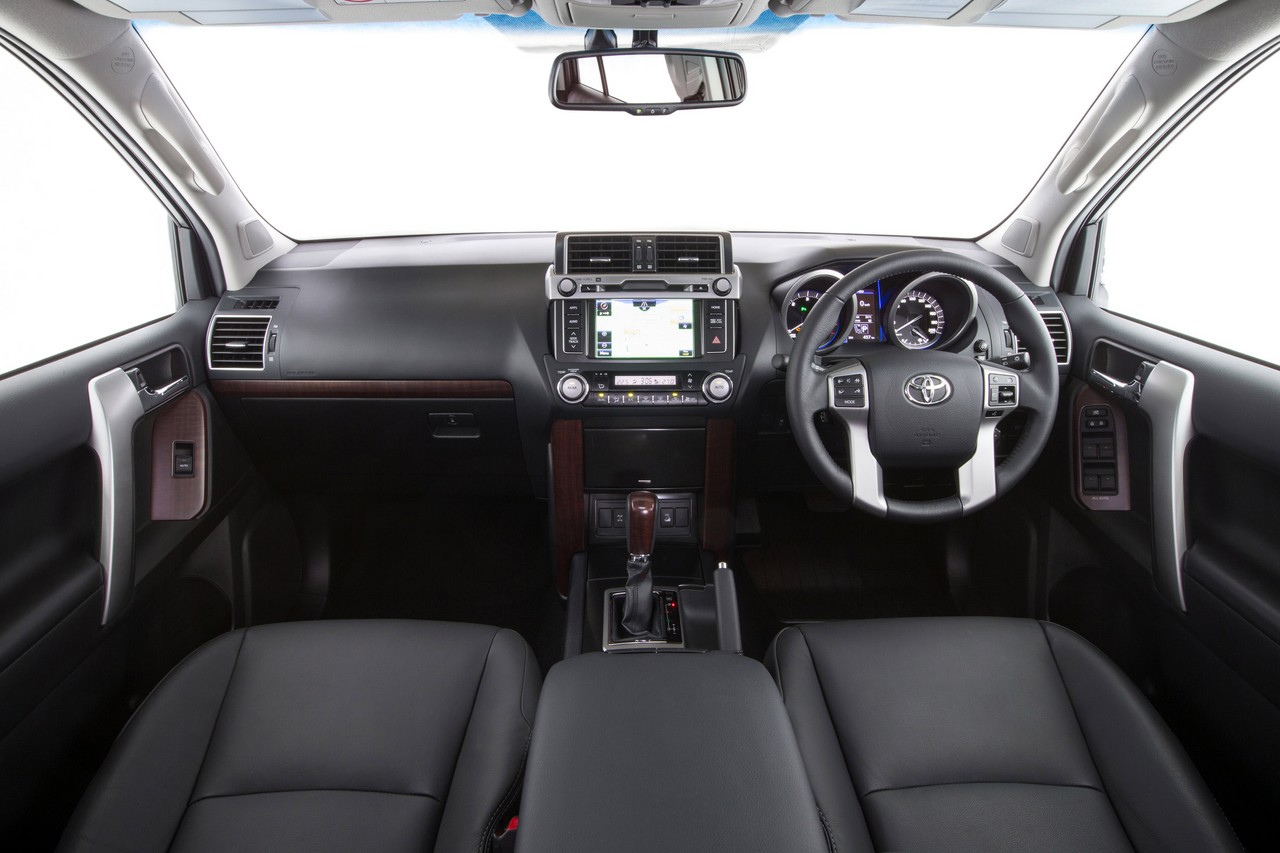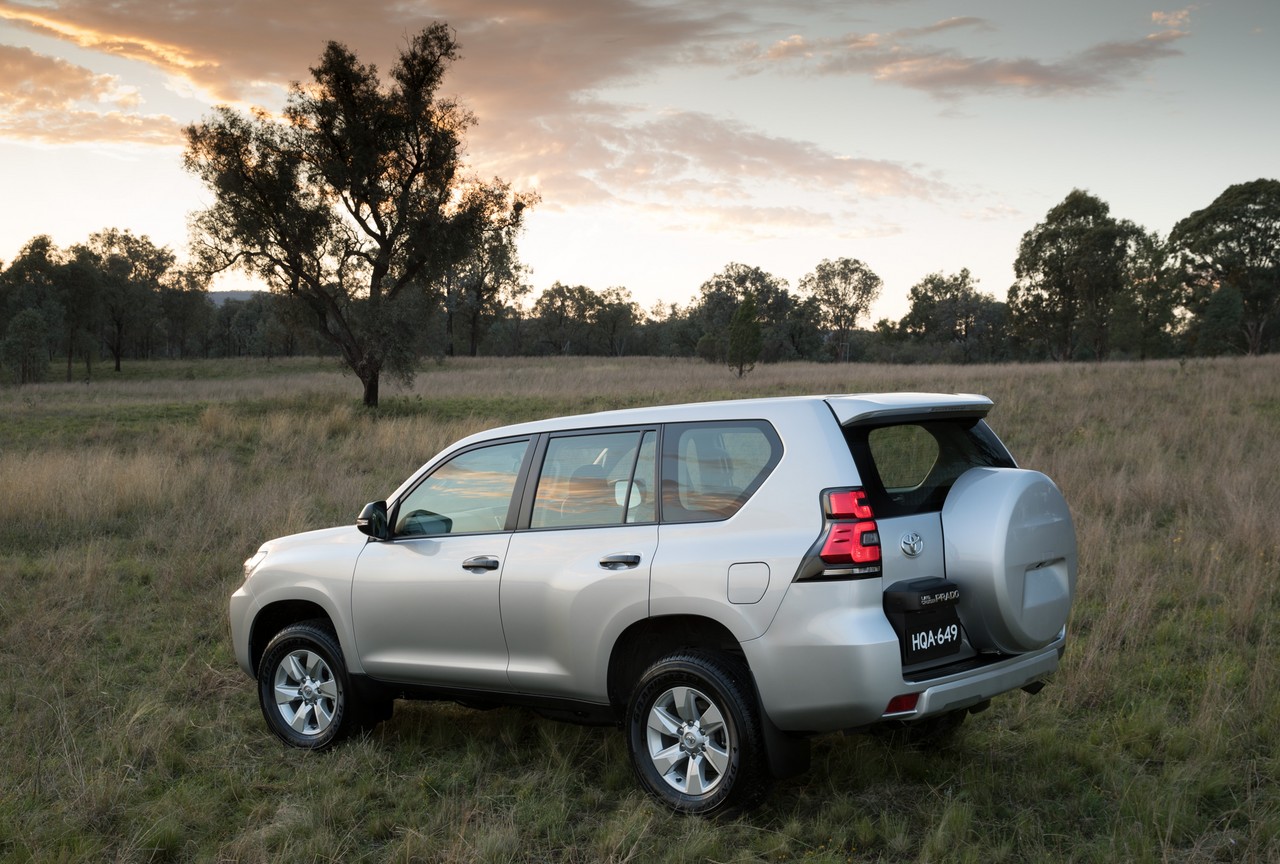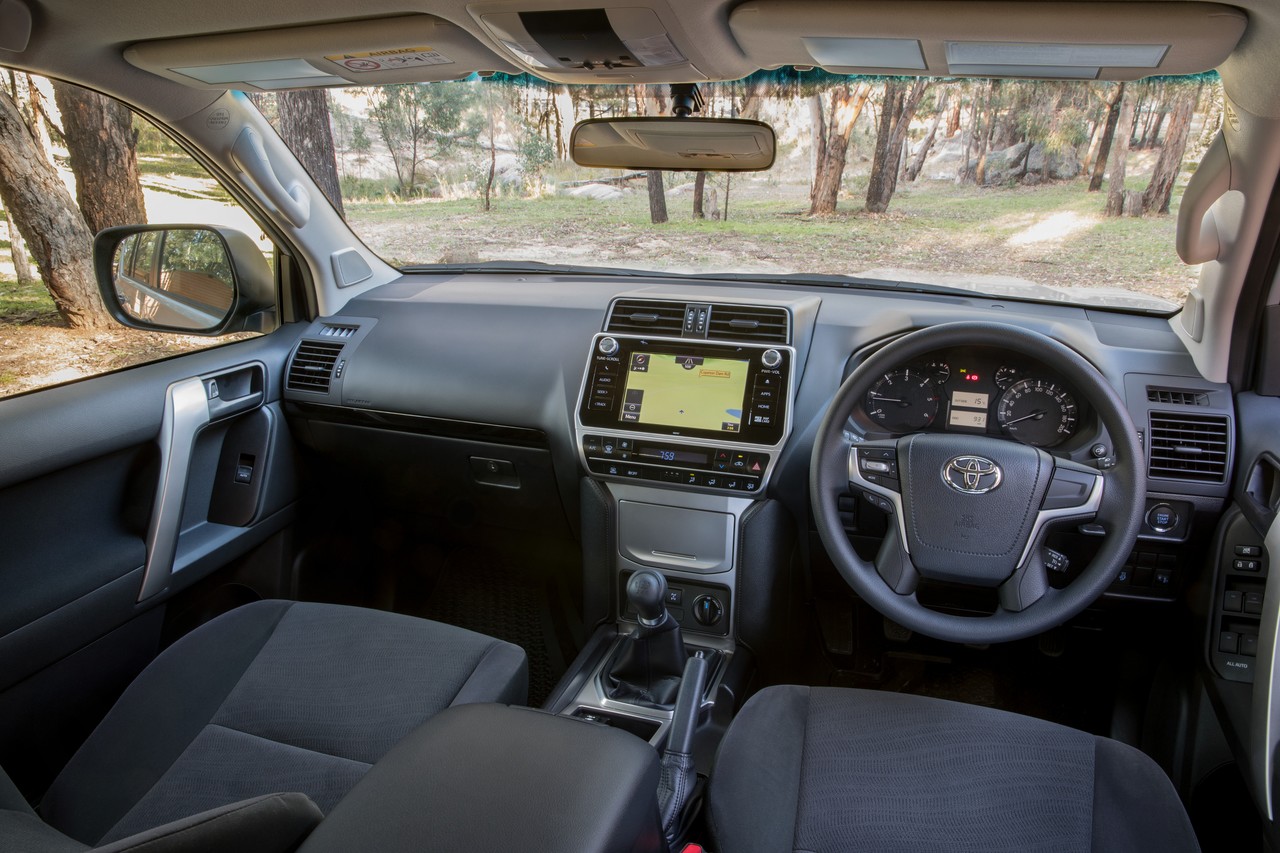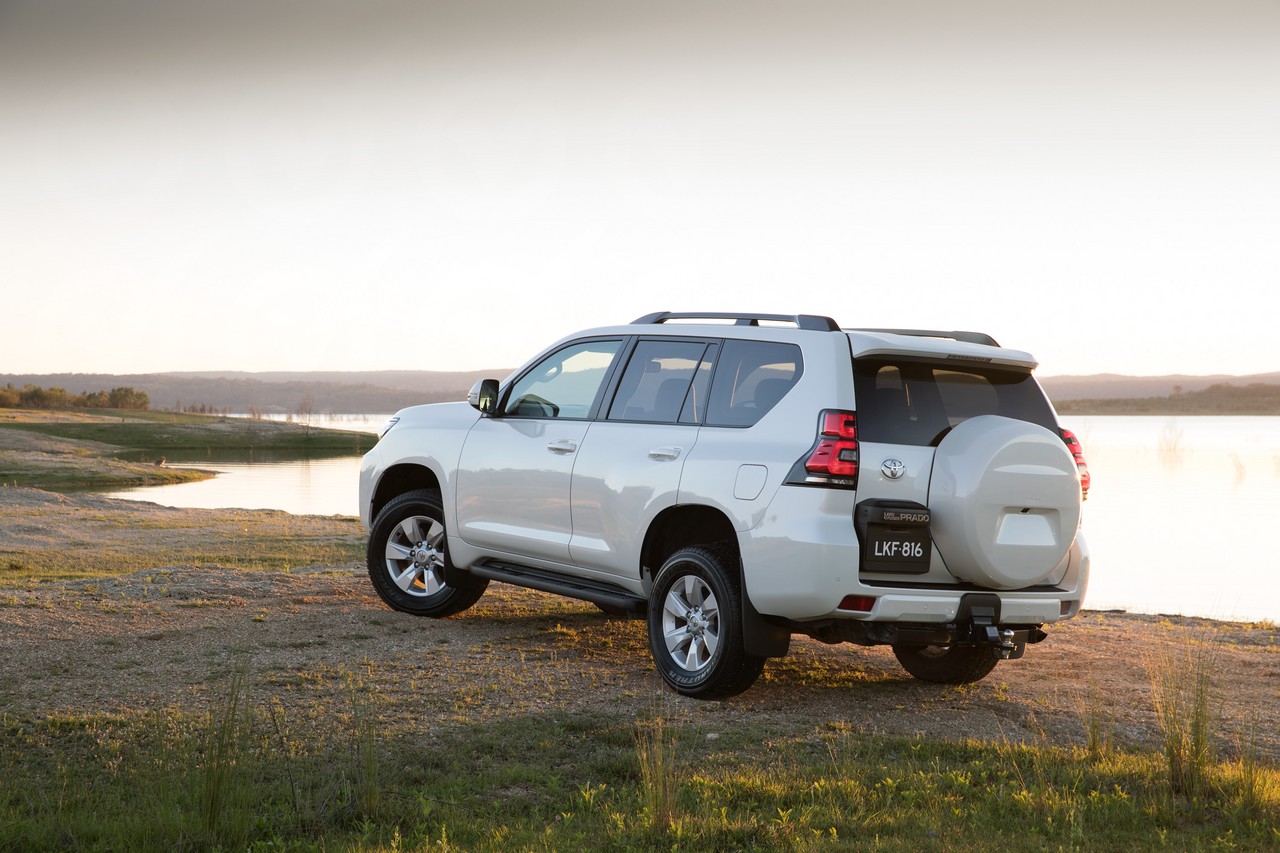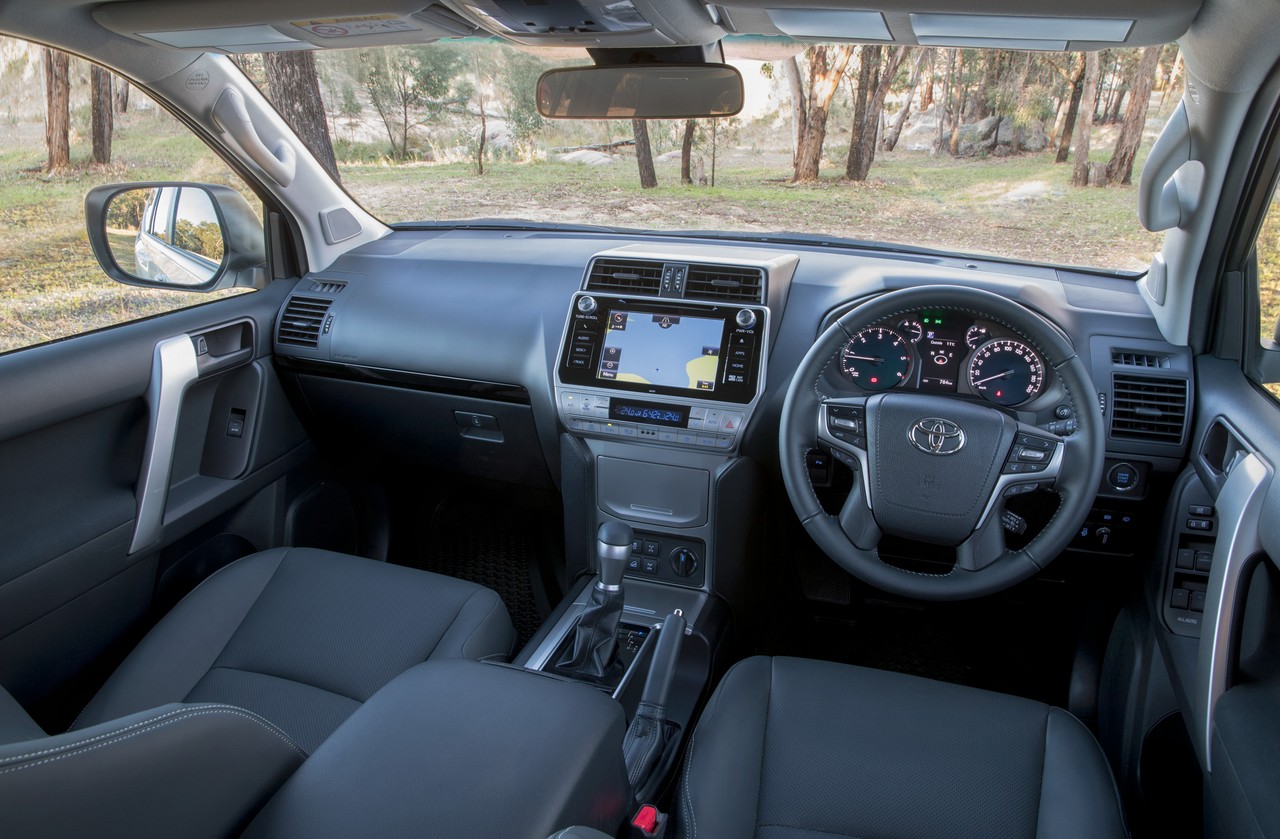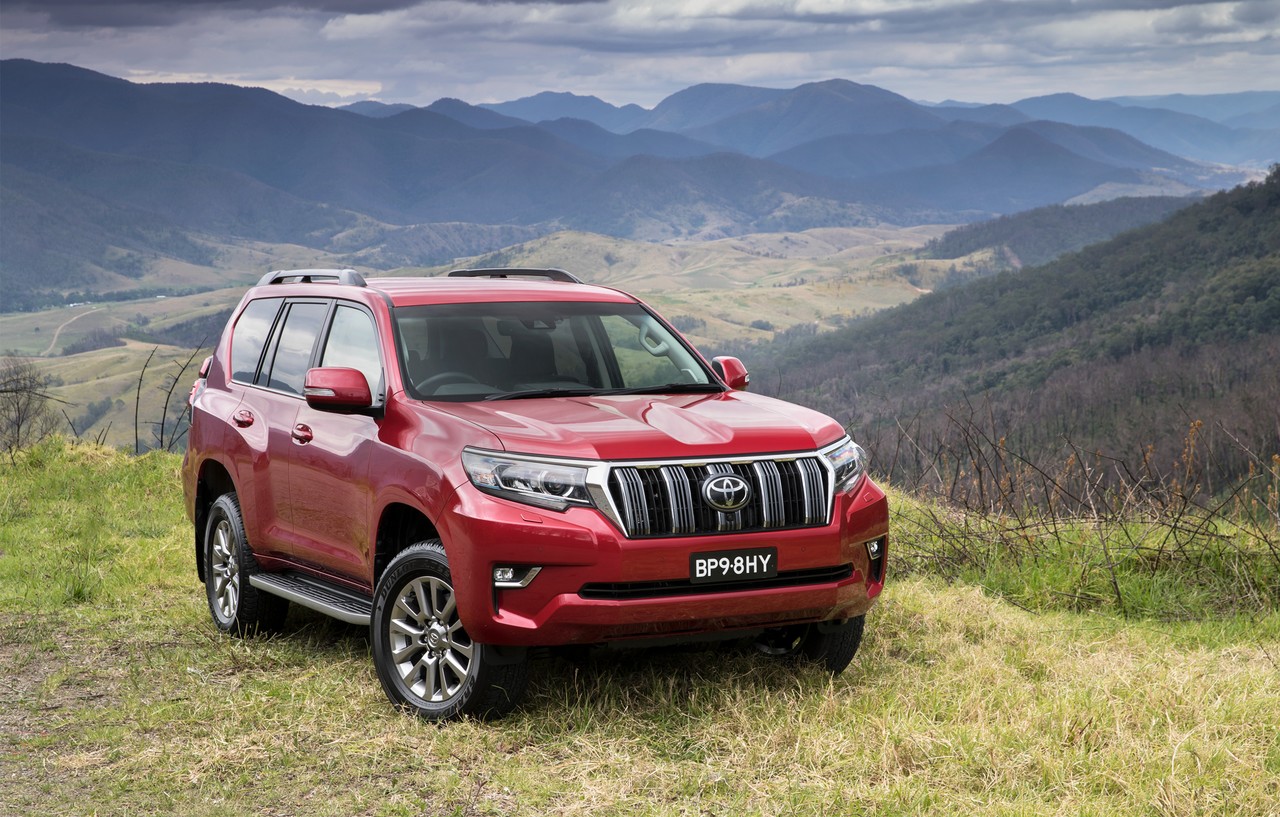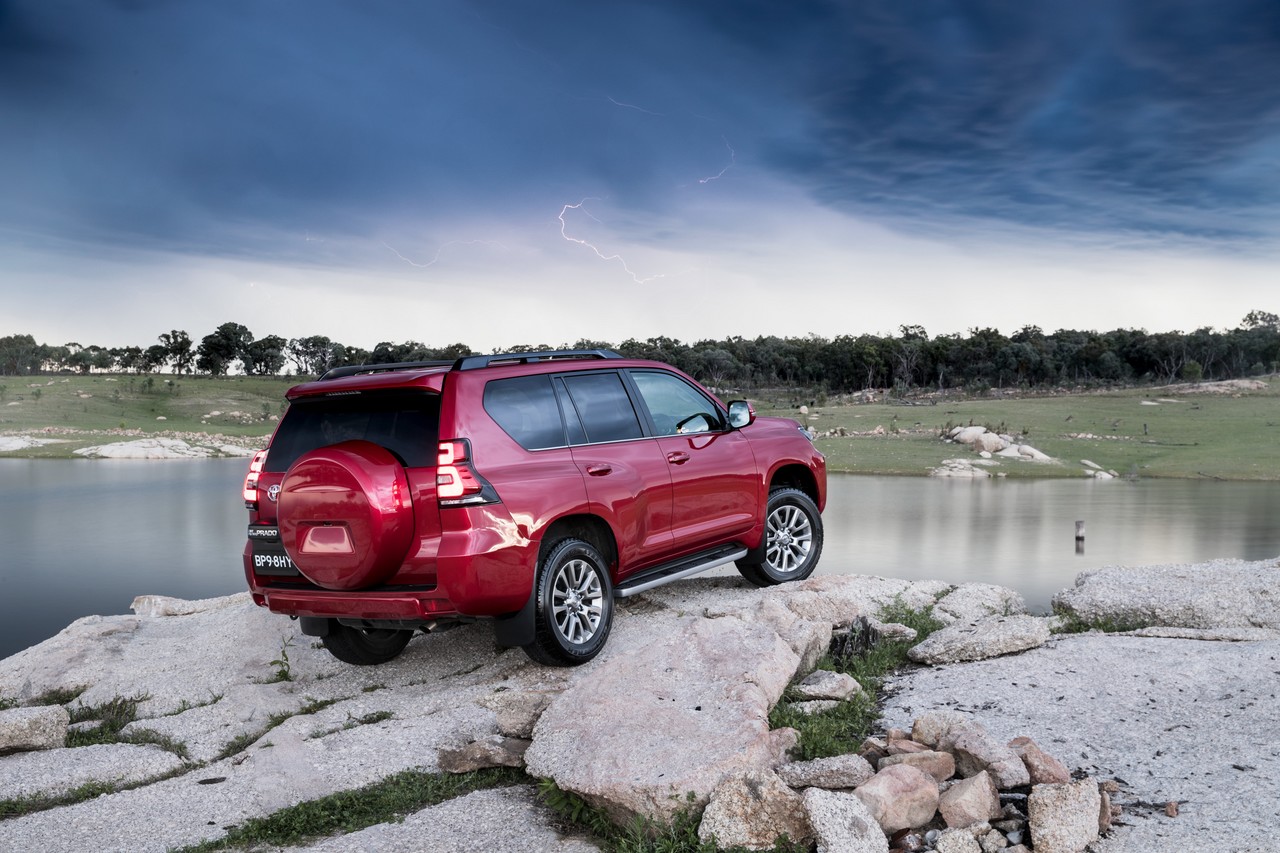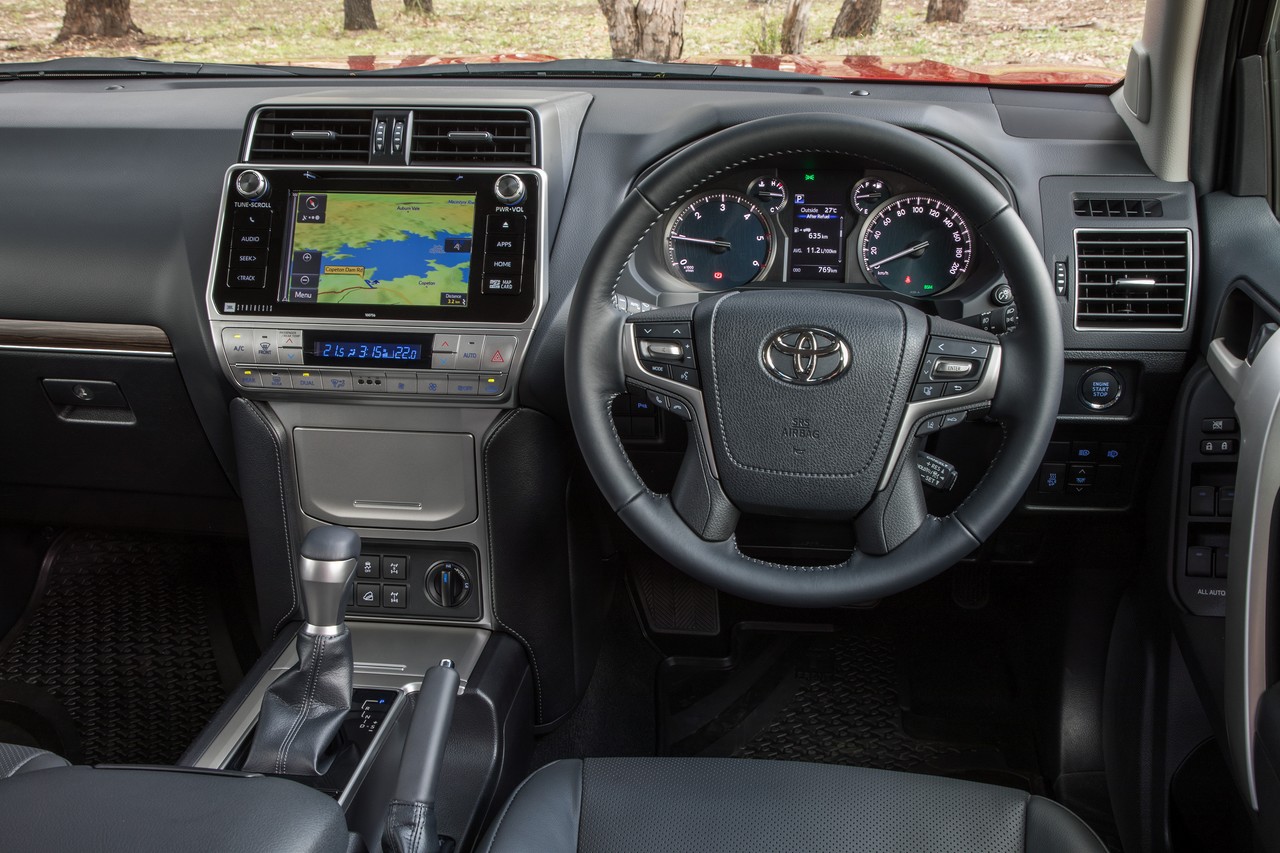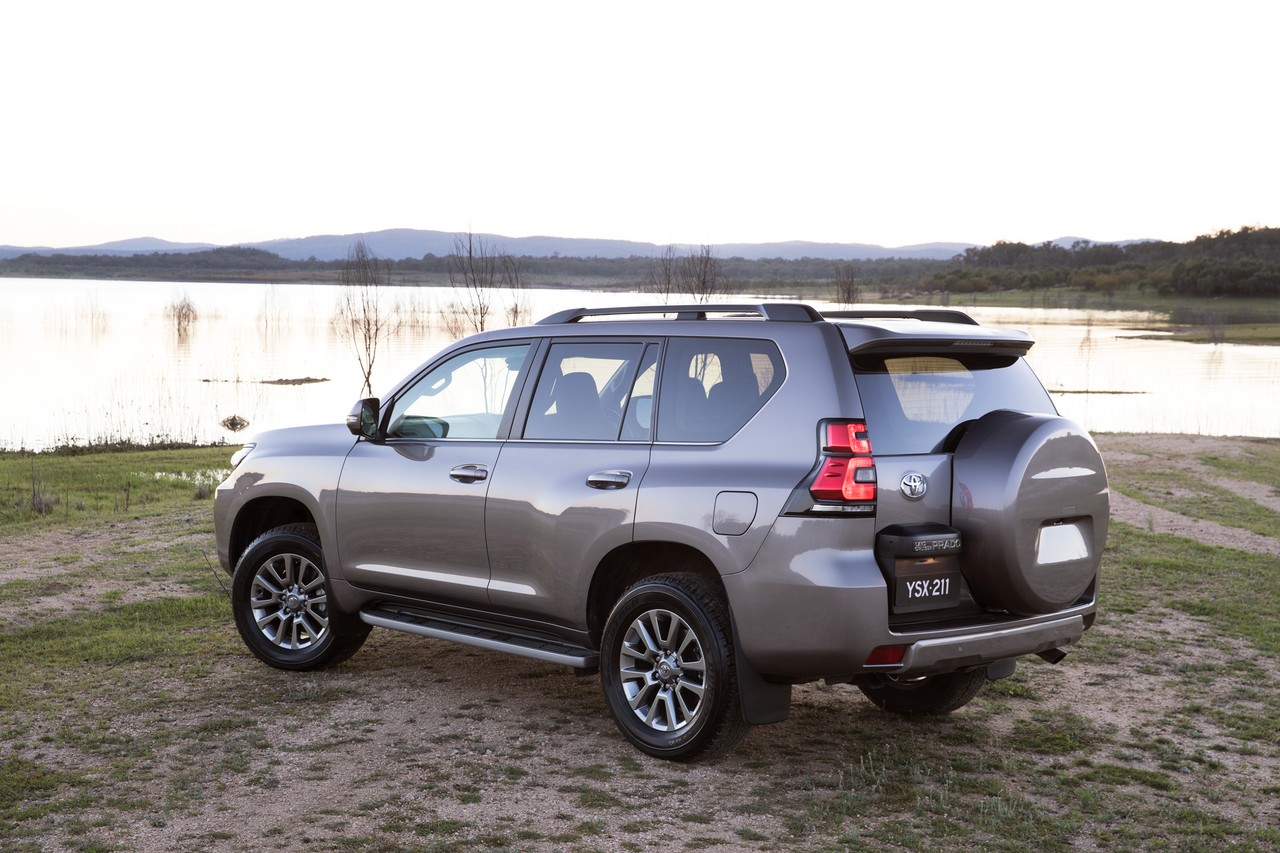
- Off-road capability, especially Kakadu variant
- For LandCruiser Prado Kakadu, Adaptive Variable Suspension improves body control
- High standard of interior fit and finish
- Light steering makes for easy manoeuvring
- Generally comfortable ride…
- … though suspension lacks low-speed compliance
- 3.0-litre 1KD-FTV diesel engine lacks torque and refinement
- Ponderous dynamics and body roll when cornering
- Impractical swing-out tailgate
Review: Toyota 150-I LandCruiser Prado (2009-13)
Overview
Released in November 2009, the Toyota 150-Series Mk.I (150-I) LandCruiser Prado was a four-wheel drive wagon. Manufactured in Japan, the Toyota LandCruiser Prado was available in three or five door models – the latter available with five or seven seats – and powered by either a 3.0-litre four-cylinder turbo-diesel engine (1KD-FTV) or a 4.0-litre petrol V6 (1GR-FE). Furthermore, the Landcruiser Prado range consisted of six variants: GX, GXL, SX, VX, ZR and Kakadu.
1KD-FTV and 1GR-FE engines
Of the engines,
- The 3.0-litre 1KD-FTV diesel V6 engine had a cast iron block and alloy cylinder head, a variable geometry turbocharger, intercooler, double overhead camshafts, electronic direct injection, twin counter-rotating balance shafts, electronic throttle control, exhaust gas recirculation and a compression ratio of 17.9:1; and,
- The 4.0-litre 1GR-FE V6 petrol engine had an alloy block and cylinder head, double overhead camshafts (per cylinder bank, chain-driven), four valves per cylinder, variable intake valve timing (VVT-i), two-stage Acoustic Control Induction System (ACIS), electronic throttle control and a compression ratio of 10.0:1.
| Body | Variant | Seats | Engine | Trans. | Peak power | Peak torque |
|---|---|---|---|---|---|---|
| 3dr wagon | SX, ZR |
5 | 3.0-litre turbo-diesel I4 (1KD-FTV) | 5sp auto | 127 kW at 4400 rpm | 410 Nm at 1600-2800 rpm |
| 5dr wagon | GX | 5 | 3.0-litre turbo-diesel I4 (1KD-FTV) | 5sp auto, 6sp man. |
127 kW at 4400 rpm | 410 Nm at 1600-2800 rpm |
| GXL | 7 | 3.0-litre turbo-diesel I4 (1KD-FTV) | 5sp auto, 6sp man. |
127 kW at 4400 rpm | 410 Nm at 1600-2800 rpm | |
| 7 | 4.0-litre petrol V6 (1GR-FE) | 5sp auto, 6sp man. |
202 kW at 5600 rpm | 381 Nm at 4400 rpm | ||
| VX, Kakadu |
7 | 3.0-litre turbo-diesel I4 (1KD-FTV) | 5sp auto | 127 kW at 4400 rpm | 410 Nm at 1600-2800 rpm | |
| 7 | 4.0-litre petrol V6 (1GR-FE) | 5sp auto | 202 kW at 5600 rpm | 381 Nm at 4400 rpm |
4WD system
The Toyota LandCruiser Prado was fitted with a full-time four-wheel drive system which included a Torsen limited-slip centre differential. Furthermore, the dual-range transmissions could be engaged via a rotary knob and the low-range gears had a transfer ratio of 2.566:1.
The VX and Kakadu variants were fitted with Toyota’s Kinetic Dynamic Suspension System (‘KDSS’), which varied stabiliser bar resistance according to driving conditions. In addition to KDSS, the Kakadu and ZR were further equipped with:
- An electronic rear differential lock;
- CRAWL control, which maintained a fixed speed in low-range gears; and,
- A Multi-Terrain Select (‘MTS’) system.
The Kakadu was also equipped with Adaptive Variable Suspension (‘AVS’ which provided variable ride height and automatic vehicle levelling) and height-adjustable rear air suspension (‘Automatic Height Control’).
Dimensions
Compared to the 120-Series LandCruiser Prado , the five-door 150-Series LandCruiser Prado was 80 mm longer (at 4930 mm), 10 mm wider (1885 mm) and 15 mm lower (1890 mm), though wheelbase length was unchanged (2790 mm). Compared to the five-door models, the three-door LandCruiser Prados were 445 mm shorter (at 4485 mm) and had a 335 mm shorter wheelbase (2455 mm).
Suspension
The 150-Series LandCruiser Prado had all-coil suspension with double wishbone front suspension and a five-link live rear axle.
Safety equipment
Standard safety equipment for the Toyota 150-I Landcruiser Prado included dual front airbags, a driver’s knee airbag, front side airbags, full length curtain airbags (i.e. for all three rows of occupants where present), ABS, electronic brake force distribution, brake assist, electronic stability control, traction control, active front seat head restraints and front seatbelts with pretensioners and force limiters. All automatic models were also equipped with Hill start Assist Control (‘HAC’) and Downhill Assist Control (‘DAC’).
From November 2011, the LandCruiser Prado Kakdu was equipped with Toyota’s Pre-Collision Safety System (PCSS). The Pre-Collision Safety System could detect the distance and relative speed of the vehicle ahead. Initially, a warning tone would sound to alert the driver of a possible collision. In its secondary stage, the system would increase braking assistance. If the driver failed to respond, the system would automatically apply the brakes and pre-tension the front seatbelts.
Brakes
The Toyota LandCruiser Prado had 338 mm by 32 mm ventilated front disc brakes with four-piston calipers and 312 mm by 18 mm ventilated rear brake discs with single-piston calipers.
ANCAP crash testing
In ANCAP crash testing , a five-door Toyota LandCruiser Prado GXL received a five star adult occupant protection rating with a score of 35.11 out of 37. In the offset crash test, there was a slight risk of serious leg injury for the front occupants. A default score was awarded in the side impact test and a further two points were received in the pole test.
Features: three-door Prado
Of the three-door models, standard features for the entry-level LandCruiser Prado SX included 17-inch alloy wheels, a six speaker sound system with CD player, Bluetooth connectivity, iPod control, USB auxiliary input and 3.5 mm input jack, a 4.3-inch TFT display, dual zone climate control air conditioning, a 4.2-inch information display, rear view camera, rear parking sensors, front fog lights, a leather-wrapped steering wheel, remote central locking with proximity key, power windows and mirrors, tilt and telescopic steering column adjustment, 12 volt power outlets, a 220 volt rear accessory socket, UV-cut glass, cargo blind, roof rails, side steps, an alarm and immobiliser.
The LandCruiser Prado ZR added a 18-inch alloy wheels, a twelve speaker Pioneer sound system with a six-stack CD/DVD player and seven-inch LED backlit touch screen, a DVD-based satellite navigation system, leather-accented seat and door trim, heated front seats, front parking sensors, a four-camera Multi-Terrain Monitor, reverse parking guidance, automatic headlights, rain-sensing wipers, moonroof and privacy glass.
Features: five-door Prado
Of the five door models, standard features on the entry-level LandCruiser Prado GX included 17-inch alloy wheels, a six speaker sound system with CD player, iPod control, Bluetooth connectivity, USB auxiliary input and 3.5 mm input jack, a 4.3-inch TFT display, air conditioning, cruise control, remote central locking with proximity key, power windows and mirrors, tilt and telescopic steering column adjustment, 12 volt power outlets, a 220 volt rear accessory socket, UV-cut glass, rear spoiler, an alarm and immobiliser. Inside, the second row of seats had a 40/20/40 split and the third row of seats – where fitted – could fold into the floor.
The LandCruiser Prado GXL was further equipped with three-zone climate control, rear camera, rear parking sensors, 4.2-inch information display, steering wheel audio controls, front fog lamps, roof rails, side steps, cargo cover and a leather steering wheel and gearshift knob.
The LandCruiser Prado VX was distinguished by its 18-inch alloy wheels, a nine speaker sound system with six-stack CD player, leather-accented seat and door trim, heated front seats, high intensity discharge (HID) projector headlights with washers, front parking sensors, automatic headlights, rain-sensing wipers, a power adjustable steering column, power-folding third row seats, privacy glass and an electrochromatic rear vision mirror.
Finally, the range-topping LandCruiser Prado Kakadu was equipped with a fourteen speaker Pioneer sound system with a seven-inch LED backlit touch screen, a DVD-based touch-screen satellite navigation system, four-camera Multi-Terrain Monitor, reverse parking guidance, refrigerated coolbox, leather-accented and ‘wood-look’ steering wheel, moonroof and a rear seat entertainment system including a nine-inch touch display with DVD player, three wireless headphone sets, two headphone jacks and an AV input.
November 2011: LandCruiser Prado update
In November 2011, the 150-Series LandCruiser Prado underwent a minor update as the ZR and Kakadu variants were fitted with Dynamic Radar Cruise Control (which could maintain a preset distance from the vehicle ahead), while VX variants and above were fitted with a 17 speaker JBL audio system with auxiliary inputs (3.5 mm/USB) and satellite navigation as standard. Furthermore, the Kakadu variants were fitted with Toyota’s Pre-Collision Safety System (see ‘Safety equipment’, above) and Bluetooth connectivity.
2012 and 2013 Toyota LandCruiser Prado Altitude
In March 2012 and May 2013, limited-run seven-seat Altitude variants were released. Compared to the GXL, the Altitude was fitted with a fourteen speaker sound system with a six-disc CD/DVD changer, satellite navigation system with a seven-inch touch-screen display, leather seat trim, front and rear parking sensors, a reversing camera with parking guidance, a rear-seat entertainment system as per the Kakadu, tilt-and-slide moonroof and privacy glass.
Brochures
- Brochure: Toyota 150.I LandCruiser Prado (November 2009)
- Brochure: Toyota 150-I LandCruiser Prado – 3 door (February 2013)
Related links
- Press Kit: Toyota 150-I LandCruiser Prado (November 2009)
- Press Release: Toyota 150-I LandCruiser Prado three-door (October 2009)
- Press Release: Toyota 150-I LandCruiser Prado Altitude (March 2012)
- Press Release: Toyota 150-I LandCruiser Prado Altitude (May 2013)
Review: Toyota 150-II Landcruiser Prado (2013-15)
Overview
Released in November 2013, the Toyota 150-Series Mk.II (150-II) Landcruiser Prado introduced a subtle facelift, upgraded interior and additional features; the range was also revised as the three-door models were discontinued.
Visually, the Toyota 150-II Landcruiser Prado could be identified by its deeper front bumper, a five-bar vertical grille (integrated with the new headlights clusters) and new alloy wheel designs; the VX and Kakadu variants were also fitted with LED headlights and daytime running lights.
Inside, there were new audio systems with seven-inch displays, a redesigned dashboard and instrument cluster. For the latter, both the VX and Kakadu variants received ‘Optitron’ backlit instruments and a 4.2-inch TFT display that provided off-road driving assistance (including individual wheel traction control, steering angle and differential lock operation). For all variants, the forward folding angle of the second row seats was increased for improved access to the third row of seats.
For LandCruiser Prado VX and Kakadu variants, the Kinetic Dynamic Suspension System (KDSS) was improved through the introduction of its own ECU and increased diameter front-cylinder rods and rear-cylinder pistons. For Kakadu variants, the ‘Multi-Terrain Select’ function gained a fifth driving mode for rocks and dirt (in addition to rock, loose rock, mud and sand, and moguls modes).
| Body | Variant | Seats | Engine | Trans. | Peak power | Peak torque |
|---|---|---|---|---|---|---|
| 5dr wagon | GX | 5, 7 (opt) |
3.0-litre turbo-diesel I4 (1KD-FTV) | 5sp auto, 6sp man. |
127 kW at 4400 rpm | 410 Nm at 1600-2800 rpm |
| GXL | 7 | 3.0-litre turbo-diesel I4 (1KD-FTV) | 5sp auto, 6sp man. |
127 kW at 4400 rpm | 410 Nm at 1600-2800 rpm | |
| 7 | 4.0-litre petrol V6 (1GR-FE) | 5sp auto, 6sp man. |
202 kW at 5600 rpm | 381 Nm at 4400 rpm | ||
| VX, Kakadu |
7 | 3.0-litre turbo-diesel I4 (1KD-FTV) | 5sp auto | 127 kW at 4400 rpm | 410 Nm at 1600-2800 rpm | |
| 7 | 4.0-litre petrol V6 (1GR-FE) | 5sp auto | 202 kW at 5600 rpm | 381 Nm at 4400 rpm |
Safety equipment
Compared to its 150-I predecessor, standard safety equipment for the 150-II Landcruiser Prado was improved with the introduction of trailer sway control and emergency braking signals which flashed during hard brake applications.
The LandCruiser Kakadu variants gained a blind spot monitor and continued to be fitted with Toyota’s Pre-Collision Safety System and Dynamic Radar Cruise Control (previously introduced in November 2011).
Features: Prado GX, GXL, VX and Kakadu
Standard features for the LandCruiser Prado GX included 17-inch six-spoke alloy wheels, a six speaker sound system with a CD player, MP3/AAC-compatibility, auxiliary inputs (3.5 mm/USB/iPod) and Bluetooth audio streaming, air conditioning, cruise control, a reversing camera, steering wheel audio controls, Bluetooth mobile phone connectivity, remote central locking with a proximity key, power windows and mirrors, tilt and telescopic steering column adjustment, 12 volt power outlets, a 220 volt rear power outlet, UV-cut glass, illuminated vanity mirrors, a trip computer and an immobiliser. GX variants with automatic transmissions were also fitted with Hill-Start Assist Control (HAC) and Downhill Assist Control (DAC).
The LandCruiser Prado GXL was further equipped with three-zone climate control air conditioning, front fog lights, rear parking sensors, power retracting and heated mirrors, privacy glass, roof rails, side steps, a roller blind-type tonneau cover and an alarm.
Beyond this, the LandCruiser Prado VX added 18-inch twelve-spoke alloy wheels, a 17 speaker JBL sound system with digital radio (DAB+), satellite navigation with touchscreen, leather seats, heated front and outboard second row seats, front parking sensors, LED headlights and daytime running lights, automatic headlights, rain-sensing wipers, a power adjustable steering wheel, power folding third row seat, an electrochromatic rear view mirror, luggage utility rails.
Finally, the LandCruiser Prado Kakadu was were fitted with a four-camera Multi-Terrain Monitor, refrigerated cool box, a rear-seat entertainment system with a Blu-ray player and nine-inch roof-mounted monitor, moonroof and driver memory settings (for the seat and steering wheel).
2014 and 2015 Landcruiser Prado Altitude
The LandCruiser Prado Altitude was released in August 2014 and February 2015 was solely available with a 3.0-litre turbo-diesel engine. Unlike other LandCruiser Prado variants, the spare tyre for the Altitude was located under the vehicle (rather than fitted to the rear door) and the Altitude had a separate glass tailgate.
Compared to the GXL variant on which it was based, the Landcruiser Prado Altitude was further equipped with a fourteen speaker JBL sound system with digital radio (DAB+), a satellite navigation system with a seven-inch display and SUNA live traffic updates, leather-accented seats (trimmed with contrasting grey seat inserts and stitching on the bolsters and headrests), power adjustable front seats, rain-sensing wipers, a tilt-and-slide moonroof, Blu-Ray rear entertainment system with three wireless headphones and remote control, and an electrochromatic rear view mirror
Visual cues for the Landcruiser Prado Altitude included chrome side mouldings and chrome door handles; inside, there were chrome highlights surrounding the air conditioning controls and carbon fibre-look details on the dash panel and gearshift surround.
Brochures
- Brochure: Toyota 150-II LandCruiser Prado – 5 door (October 2013)
- Brochure: Toyota 150-II LandCruiser Prado Altitude (August 2014)
Related links
- Press Kit: Toyota 150-II LandCruiser Prado (November 2013)
- Press Release: Toyota 150-II Landcruiser Prado Altitude (August 2014)
- Press Release: Toyota 150-II Landcruiser Prado Altitude (February 2015)
Review: Toyota 150-III Landcruiser Prado (2015-17)
Overview
Released in Australia in August 2015, the Toyota 150-Series Mk.III (150-III) Landcruiser Prado introduced Toyota’s 2.8-litre 1GD-FTV turbo-diesel engine, a revised 4.0-litre 1GR-FE V6 petrol engine and new six-speed AC60F automatic transmission. Both engines complied with Euro V emissions standards.
1GD-FTV engine
The 1GD-FTV four-cylinder diesel engine had 92.0 mm bores and a 90.0 mm stroke for a capacity of 2755 cc, common-rail injection, a variable nozzle turbocharger (VNT) manufactured by Toyota, intake manifold with swirl control valve, double overhead camshafts (chain-driven), four valves per cylinder actuated by roller rockers, compression ratio of 15.6:1, water-cooled exhaust gas recirculation (EGR), a diesel particulate filter and counterbalance shaft.
1GR-FE engine
For the 1GR-FE engine, changes included:
- Upgraded injectors for improve fuel flow and atomisation;
- A modified exhaust system for improved gas flow and cylinder scavenging; and,
- Revised ECU mapping.
| Variant | Seats | Engine | Trans. | Peak power | Peak torque |
|---|---|---|---|---|---|
| GX | 5, 7 (opt) |
2.8-litre turbo-diesel I4 (1GD-FTV) | 6sp man. | 130 kW at 3400 rpm | 420 Nm at 1400-2600 rpm |
| 6sp auto | 130 kW at 3400 rpm | 450 Nm at 1600-2400 rpm | |||
| GXL | 7 | 2.8-litre turbo-diesel I4 (1GD-FTV) | 6sp man. | 130 kW at 3400 rpm | 420 Nm at 1400-2600 rpm |
| 6sp auto | 130 kW at 3400 rpm | 450 Nm at 1600-2400 rpm | |||
| 7 | 4.0-litre petrol V6 (1GR-FE) | 6sp auto | 207 kW at 5600 rpm | 381 Nm at 4400 rpm | |
| VX, Kakadu |
7 | 2.8-litre turbo-diesel I4 (1GD-FTV) | 6sp man. | 130 kW at 3400 rpm | 420 Nm at 1400-2600 rpm |
| 6sp auto | 130 kW at 3400 rpm | 450 Nm at 1600-2400 rpm | |||
| 7 | 4.0-litre petrol V6 (1GR-FE) | 6sp auto | 207 kW at 5600 rpm | 381 Nm at 4400 rpm |
Safety equipment
For the 150-III Landcruiser Prado Kakadu, standard safety equipment was extended to include Rear Cross Traffic Alert (RCTA) which could warn the driver of approaching vehicles when reversing out of a parking space. Specifically, RCTA operated when the Landcruiser Prado Kakadu was reversing at less than 8 km/h and the approaching vehicles were approaching at speeds between 8 km/h and 28 km/h.
Features
Compared to its 150-II predecessor, standard features for the 150-III Landcruiser Prado GXL were extended to include a nine speaker sound system (previously six) and satellite navigation. The navigation system included SUNA Live Traffic Alerts and a ‘navigate to destination’ function for the ‘Toyota Link’ connected mobility menu.
2017 Toyota LandCruiser Prado Altitude
The Toyota LandCruiser Prado Altitude was officially released in April 2017 and powered by a 2.8-litre 1GD-FTV turbo diesel engine that was mated to a six-speed automatic transmission. The LandCruiser Prado Altitude omitted the second fuel tank of the standard LandCruiser Prado so that its spare tyre could be mounted underneath the vehicle (rather than on the tailgate). Furthermore, the LandCruiser Prado Altitude had a rear glass hatch that could open independently of the tailgate.
Visually, the LandCruiser Prado Altitude could be identified by its new 18-inch alloy wheels and chrome side mouldings. Relative to the GXL variant, features were extended to include a JBL audio system with fourteen speakers, digital radio tuner (DAB+), leather-accented upholstery, power adjustable front seats, auto-levelling LED headlamps, rear seat entertainment system (with Blu-ray player, a ceiling-mounted nine-inch monitor, 5.1 channel surround sound, wireless headphones and remote control) and a tilt-and-slide moonroof.
Brochure
Related links
- Press Kit: Toyota 150-III LandCruiser Prado (August 2015)
- Press Release: Toyota LandCruiser Prado Altitude (April 2017)
Review: Toyota 150-IV Landcruiser Prado (2017-23)
Overview
Released in Australia in November 2017, the Toyota 150-Series Mk.IV (150-IV) LandCruiser Prado introduced a revised range that was solely powered by 2.8-litre turbo diesel engines.
Visually, the 150-IV LandCruiser Prado could be identified by its front bonnet that was ‘sculpted in the centre to enhance downward visibility’, re-profiled fenders ‘to help drivers more easily locate the vehicle[‘s] extremities’, a revised grille with broad vertical bars and chrome-finished cooling openings, and restyled headlamps with main beams positioned inboard to avoid obstacles from off-road driving. Furthermore, the lower corners on the new front and rear bumpers ‘kick[ed] upwards to enhance off-road manoeuvrability’, while the rear mask had new tail-lamp clusters and a smaller rear garnish plate incorporated within the number-plate surround.
Inside, the 150-IV LandCruiser Prado had a new dashboard, eight-inch colour touchscreen as standard (previously seven-inch for GXL, VX and Kakadu), instrument binnacle and switchgear. Beyond this, the revised centre console incorporated a flush-surface air-conditioning control panel and had a lower profile for improved forward visibility.
| Variant | Seats | Engine | Trans. | Peak power | Peak torque |
|---|---|---|---|---|---|
| GX | 5, 7 (opt) |
2.8-litre turbo-diesel I4 (1GD-FTV) | 6sp man. | 130 kW at 3400 rpm | 420 Nm at 1400-2600 rpm |
| 6sp auto | 130 kW at 3400 rpm | 450 Nm at 1600-2400 rpm | |||
| GXL | 7 | 2.8-litre turbo-diesel I4 (1GD-FTV) | 6sp man. | 130 kW at 3400 rpm | 420 Nm at 1400-2600 rpm |
| 6sp auto | 130 kW at 3400 rpm | 450 Nm at 1600-2400 rpm | |||
| VX, Kakadu |
7 | 2.8-litre turbo-diesel I4 (1GD-FTV) | 6sp man. | 130 kW at 3400 rpm | 420 Nm at 1400-2600 rpm |
| 6sp auto | 130 kW at 3400 rpm | 450 Nm at 1600-2400 rpm |
Safety equipment
For the Toyota 150-IV LandCruiser Prado, standard safety equipment for models with automatic transmissions was extended to include:
- Pre-Collision Safety System (PCSS): used a forward-facing camera and radar sensor to detect obstacles and pedestrians ahead. If there was a collision risk, the driver would initially receive warnings and, if the driver failed to act, autonomous emergency braking would be initiated. Prior to the 150-IV LandCruiser Prado, PCSS had been limited to the Kakadu variants and did not include pedestrian detection;
- Active Cruise Control (ACC): when cruise control was active, ACC used a milliwave radar to monitor the distance to the vehicle ahead and could apply the brakes to maintain a safe distance. If the road ahead was clear, the vehicle would accelerate to its previously set cruising speed. Prior to the 150-IV LandCruiser Prado, ACC had been limited to the Kakadu variants;
- Lane Departure Alert (LDA): used a camera to detect lane markings and monitors the vehicle’s position within those markings. If the vehicle began to deviate from its lane without the indicators having been applied, the system would issue visual and audible warnings; and,
- Automatic High Beam (AHB): could detect the headlights or taillights of vehicles ahead and automatically switch between high and low beams to avoid dazzling other drivers.
Furthermore, the LandCruiser Prado VX gained a Blind Spot Monitor and Rear Cross Traffic Alert (previously limited to the LandCruiser Prado Kakadu).
Features
The Toyota 150-IV LandCruiser Prado introduced the following changes to standard features:
- The LandCruiser Prado GX gained satellite navigation and ‘Toyota Link’ smartphone connectivity;
- The LandCruiser Prado GXL gained bi-LED headlamps, LED daytime running lights with ‘follow me’ function, LED fog lamps and sun-visor lamps;
- LandCruiser Prado GXL and VX variants with automatic transmissions gained a rear differential lock (previously limited to the LandCruiser Prado Kakadu); and,
- LandCruiser Prado VX variants gained ventilated front seats, LED fog lamps, Toyota’s Multi-Terrain Monitor, Panoramic View camera system which could provide a virtual bird’s eye view of the vehicle underfloor view, and a cool box; and,
- LandCruiser Prado Kakadu variants gained the Panoramic View camera system and ‘Drive Mode Select’ function which enabled the driver to select from ‘Eco’, ‘Comfort’, ‘Sport’, ‘Sport S’ and ‘Sport S+’ drive modes which adjusted throttle sensitivity and transmission mapping.
For a complete list of features, please refer to the brochure below.
Brochure
Related links
